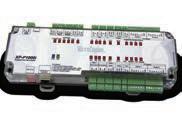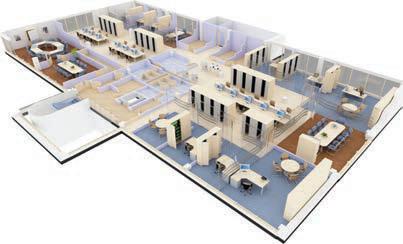





JURUTERA has an estimated readership of 168,000 professionals. Our esteemed readership consists of certified engineers, decision making corporate leaders, CEOs, government officials, project directors, entrepreneurs, project consultants, engineering consulting firms and companies involved with engineering products and services.
Our business partners can be assured that their products and services will be given the circulation and exposure it deserves, thus maintaining a sustained advertising presence to our core readers of decision-making engineers and technical experts. Our website offers an even wider market reach, with added international presence, aided by our international affiliation with official engineering bodies all over the world. Our online and offline advertising features such as banner advertising, article sponsorship and direct e-mail announcements have proven to be successful marketing strategies that will set the businesses of our partners apart from their competition.
For advertising enquiries, please contact:
(CTP)










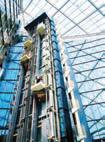



*Please note that the above prices exclude the 6% GST (Tax rate will be subjected to government changes) *The above prices exclude 15% advertising agency commission

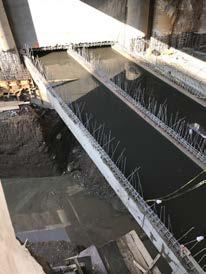
The Mixcoac-Insurgentes underpass interchange was an extraordinary engineering challenge because of the architectural complexity and operative logistics of the project. The structural composition of the 1.3 kilometre double tunnel, one directly above of the other, made this a very complex interchange.
The largest project challenge was the three existing sewer collectors along the interchange tunnels. The collectors brought important benefit to the hydraulic infrastructure by the substitution of concrete underground galleries that protect the pipes, as well as some wastewater ducts which would stay adjacent to the tunnels. In order to achieve a watertight structure, Xypex Crystalline Technology was chosen because of its ability to increase durability, to protect against any dampness or leaks and its resistance to chemical attack.
During the tunnel construction a segment of the wastewater pipes had to be replaced because of its location directly below an out-going lower tunnel. 200 kg of Xypex Concentrate was applied to the inner side of the wastewater channel and Xypex Admix C-2000 (dosed at 2%) was poured as a cover slab of this channel as well as the deck of the upper tunnel, contributing to the enhancement of durability, increased service life and reduction of future maintenance costs of this structure.
For more information on how our solutions can provide sustainable benefits for your concrete assets, please visit our website at www.xypex.com.au or LinkedIn Page.























Number 02, FEBRUARY 2018IEM Registered on 1 May 1959
MAJLIS BAGI SESI 2017/2018 (IEM COUNCIL SESSION 2017/2018)
YANG DIPERTUA / PRESIDENT
Ir. Dr Tan Yean Chin
TIMBALAN YANG DIPERTUA / DEPUTY PRESIDENT
Ir. David Lai Kong Phooi
NAIB YANG DIPERTUA / VICE PRESIDENTS
Ir. Prof. Dr Jeffrey Chiang Choong Luin, Ir. Prof. Dr Norlida bt Buniyamin, Ir. Ellias Bin Saidin, Ir. Prof. Dr Ruslan bin Hassan, Ir. Lai Sze Ching, Ir. Lee Boon Chong, Ir. Ong Ching Loon
SETIAUSAHA KEHORMAT / HONORARY SECRETARY
Ir. Yap Soon Hoe
BENDAHARI KEHORMAT / HONORARY TREASURER
Ir. Dr Wang Hong Kok
BEKAS YANG DIPERTUA TERAKHIR / IMMEDIATE PAST PRESIDENT
Y.Bhg. Dato’ Ir. Lim Chow Hock
BEKAS YANG DIPERTUA / PAST PRESIDENTS
Y.Bhg. Academician Tan Sri Dato’ Ir. (Dr) Hj. Ahmad Zaidee bin Laidin, Y.Bhg. Dato’ Ir. Dr Gue See Sew, Y.Bhg. Dato’ Paduka Ir. Keizrul bin Abdullah, Y.Bhg. Academician Dato’ Ir.
Prof. Dr Chuah Hean Teik, Ir. Choo Kok Beng
WAKIL AWAM / CIVIL REPRESENTATIVE
Ir. Dr Lee Yun Fook
WAKIL MEKANIKAL / MECHANICAL REPRESENTATIVE
Ir. Fam Yew Hin
WAKIL ELEKTRIK / ELECTRICAL REPRESENTATIVE
Ir. Lim Kim Ten
WAKIL STRUKTUR / STRUCTURAL REPRESENTATIVE
Ir. Dr Ng Soon Ching
WAKIL KIMIA / CHEMICAL REPRESENTATIVE
Ir. Prof. Dr Thomas Choong Shean Yaw
WAKIL LAIN-LAIN DISPLIN / REPRESENTATIVE TO OTHER DISCIPLINES
Ir. Roznan bin Abdul Rashid
WAKIL MULTIMEDIA DAN ICT / ICT AND MULTIMEDIA REPRESENTATIVE
Ir. Dr Chuah Joon Huang
AHLI MAJLIS / COUNCIL MEMBERS
Ir. Mohd Khir bin Muhammad, Y.Bhg. Dato’ Ir. Hj. Hanapi Bin Mohammad Noor, Ir. Dr Ahmad Anuar bin Othman, Ir. Ishak bin Abdul Rahman, Ir. Chong Pick Eng (PE Chong), Ir. Ng Yong Kong, Ir. Tejinder Singh, Ir. Sreedaran a/l Raman, Ir. Roger Wong Chin Weng, Ir. Assoc. Prof. Dr Ahmad Kamil bin Arshad, Ir. Dr Tan Kuang Leong, Ir. Hoo Choon Sean, Y.Bhg. Lt. Jen. Dato’ Wira Ir. Ismail bin Samion (Ret. RMAF), Y.Bhg. Dato’ Ir. Hj. Anuar bin Yahya, Ir. Mah Way Sheng, Ir. Gunasagaran a/l Kristnan, Ir. Chen Harn Shean, Ir. Mohd Aman bin Hj. Idris, Ir. Gopal Narian Kutty, Ir. Dr Jimmy Mok Vee Hoong, Ir. Assoc. Prof. Dr Leong Wai Yie, Ir. Razmahwata Mohamad Razalli, Ir. Abdul Razak Yakob, Ir. Yau Chau Fong, Y.Bhg. Dato’ Ir. Foong Choy Chye, Y.Bhg. Dato’ Ir. Kisai bin Rahmat, Ir. Yam Teong Sian, Y. Bhg. Dato’ Ir. Low Keng Kok, Y. Bhg. Dato’ Ir. Hj. Abdul Rashid bin Maidin
PENGERUSI CAWANGAN / BRANCH CHAIRMAN
1. Pulau Pinang: Ir. Ting Chek Choon
2. Selatan: Ir. Mohd Khir Muhammad
3. Perak: Ir. Abdul Razak bin Ali
4. Kedah-Perlis: Ir. Prof. Dr Rezuwan bin Kamaruddin
5. Negeri Sembilan: Y. Bhg. Dato’ Ir. Zainurin bin Karman
6. Kelantan: Ir. Hj. Mohd Zaim bin Abd. Hamid
7. Terengganu: Ir. Atemin bin Sulong
8. Melaka: Ir. Dr Tan Chee Fai
9. Sarawak: Ir. Vincent Tang Chok Khing
10. Sabah: Ir. Dr James Yong Hon Min
11. Miri: Ir. Paul Chiew Lik Ing
12. Pahang: Y. Bhg. Dato’ Ir. Sharuddin bin Mohd Simin
AHLI JAWATANKUASA INFORMASI DAN PENERBITAN / STANDING COMMITTEE ON INFORMATION AND PUBLICATIONS 2017/2018
Pengerusi/Chairman: Ir. Prof. Dr Ruslan Hassan Naib Pengerusi/Vice Chairman: Ir. Mohd. Khir Muhammad Setiausaha/Secretary: Ir. Lau Tai Onn Ketua Pengarang/Chief Editor: Ir. Prof. Dr Ruslan Hassan Pengarang Buletin/Bulletin Editor: Ir. Mohd. Khir Muhammad Pengarang Prinsipal Jurnal/Principal Journal Editor: Ir. Prof. Dr Ruslan Hassan Pengerusi Perpustakaan/Library Chairman: Ir. C.M.M. Aboobucker Ahli-Ahli/Committee Members: Ir. Ong Guan Hock, Ir. Yee Thien Seng, Ir. CMM Aboobucker, Ir. Chin Mee Poon, Ir. Dr Oh Seong Por, Ms. Michelle Lau Chui Chui, Ir. Abdul Razak bin Yakob, Ir. Prof. Dr Abdul Aziz bin Abdul Samad, Ir. Tejinder Singh
LEMBAGA PENGARANG/EDITORIAL BOARD 2017/2018
Ketua Pengarang/Chief Editor: Ir. Prof. Dr Ruslan Hassan Pengarang Buletin/Bulletin Editor: Ir. Mohd. Khir Muhammad Pengarang Jurnal/Journal Editor: Ir. Prof. Dr Ruslan Hassan Ahli-ahli/Committee Members: Ir. Lau Tai Onn, Ir. Ong Guan Hock, Ir. Yee Thien Seng, Ms. Michelle Lau Chui Chui, Ir. Dr Oh Seong Por Secretariats: Janet Lim, May Lee
THE INSTITUTION OF ENGINEERS, MALAYSIA
Bangunan Ingenieur, Lots 60 & 62, Jalan 52/4, P.O. Box 223, (Jalan Sultan), 46720 Petaling Jaya, Selangor Darul Ehsan.
Tel: 603-7968 4001/4002 Fax: 603-7957 7678 E-mail: sec@iem.org.my Homepage: http://www.myiem.org.my

5
COVER NOTE Mobility Engineering and Road Safety
6 - 11
COVER STORY The Construction Industry Today
13 - 28
FEATURE ARTICLES
Road Risks & Environmental Impact Assessments in Malaysian Road Infrastructure Projects ..........................................13
Shared Space Design for Urban Mobility ............19
Pedestrian Safety in Malaysia ..............................23
SAFE TEA TIME
Unsafe Behaviour is More Rewarding 30
ENGINEER’S LENS
The New Rawang Bypass 32
33 - 38
FORUMS
IEM and Miros to Enhance Collaboration in Road Safety Via Memorandum of Understanding .....................................................33
One-Day Seminar: Road Safety Audit (RSA) & Traffic Management Plan (TMP) .........................34
Formation of the Digital Hub in IEM Malaysia ....37
Chimney Tower: Labuan’s Historical Symbol of Pride 41
ENGINEER’S ADVENTURES
PAGE
46 - 48
BLUE PAGE Membership List

We are pleased to inform that IEM will be holding the 59th Annual Dinner and Awards Night 2018 on 21 April, 2018. Dimension Publishing has been appointed to put together the Annual Dinner Programme Book which will be circulated to all 1,200 guests on that night at Sunway Resort Hotel & Spa, Petaling Jaya
It is an annual event organised by IEM to present awards to winners of projects and to announce the new committee for year 2018/2019. Special guests of honour will be invited to officiate at the event.
We are now calling for interested advertisers to book their preferred advertising position in this programme book. Below please find the advertising rates for your immediate action and reply. We hope to hear from you soon before the closing date on 19 March 2018


ANNUAL DINNER AWARDS NIGHT &
2016 Programme Book
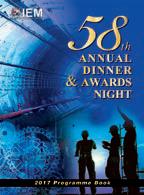
Book Size: 210mm(W) x 285mm(H). Please provide extra 6mm for bleed area on all 4 sides
Printing Specifications : 230gsm art card (Cover), 105gsm art paper (Text), 4C + 4C, Staple binding, UV varnish on Cover
Quantity: 1,200 copies
Advertisement Format : High resolution PDF file, with crop marks, bleed area, text being outlined
Deadlines : : 19 March 2018 (Mon) (Ad Booking) 26 March 2018 (Mon) (Artwork Submission)
Kindly tick in the relevant bracket. IEM reserves the right to edit, revise or reject any advertisement deemed unsuitable or inappropriate. The final print-ready artwork to be furnished by advertisers.
Message2,800
Facing Past Presidents List2,800
Facing Inside Back Cover2,800
Run-On-Page (ROP)1,900
Double Page Spread (DPS)4,500
Remarks:
• Space availability is subject to booking on first-come-first-served basis
Company logo will be appeared in the Acknowledgement Page in both IEM Dinner Programme Book and JURUTERA May 2018
• Advertising rate is subject to 6% GST. Please take note that the advertising rates shown above exclude the 6% GST
• Prices shown above exclude 15% Advertising Agency commission
• Any cancellation after signing the Advertising Contract shall result in a 50% penalty charge
• Payment term: 14 days upon invoicing
Name of Company:
Company Stamp & Authorized Signature:
Date:
Contact Person(s):
Email Address:
For advertising enquiries, please contact:
PUBLISHING
(449732-T) Level 18-01-03, PJX-HM Shah Tower, No. 16A, Persiaran Barat, 46050 Petaling Jaya, Selangor. Tel: +603 7493 1049 Fax: +603 7493 1047 Email: info@dimensionpublishing.com www.dimensionpublishing.com
DIMENSION PUBLISHING SDN. BHD. (449732-T)
Level 18-01-03, PJX-HM Shah Tower, No. 16A, Persiaran Barat, 46050 Petaling Jaya, Selangor Darul Ehsan, Malaysia.
Tel: +(603) 7493 1049 Fax: +(603) 7493 1047
E-mail: info@dimensionpublishing.com Website: www.dimensionpublishing.com
Chairman
ROBERT MEBRUER
CEO/Publisher
PATRICK LEUNG
General Manager
SHIRLEY THAM shirley@dimensionpublishing.com
Head of Marketing & Business Development
JOSEPH HOW joseph@dimensionpublishing.com
Editor
TAN BEE HONG bee@dimensionpublishing.com
Contributing Writers
PUTRI ZANINA & ZOE PHOON putri@dimensionpublishing.com zoe@dimensionpublishing.com
Senior Graphic Designer
SUMATHI MANOKARAN sumathi@dimensionpublishing.com
Graphic Designer
NABEELA AHMAD beela@dimensionpublishing.com
Advertising Consultants
THAM CHOON KIT ckit@dimensionpublishing.com
Accounts cum Admin Executive
YEN YIN yenyin@dimensionpublishing.com
For advertisement placements and subscriptions, please contact:
DIMENSION PUBLISHING SDN. BHD. (449732-T)
Level 18-01-03, PJX-HM Shah Tower, No.16A, Persiaran Barat, 46050 Petaling Jaya, Selangor Darul Ehsan, Malaysia.
Tel: +(603) 7493 1049 Fax: +(603) 7493 1047
E-mail: info@dimensionpublishing.com
Subscription Department E-mail: info@dimensionpublishing.com
Printed by
HOFFSET PRINTING SDN. BHD. (667106-V)
No. 1, Jalan TPK 1/6, Taman Perindustrian Kinrara, 47180 Puchong, Selangor Darul Ehsan, Malaysia. Mailer
PERFECT MAIL SERVICES (648839-P)
14 Jalan TSB 2, Taman Perindustrian Sungai Buloh, Sungai Buloh, Selangor Darul Ehsan, Malaysia. Tel: +(603) 6156 5288
JURUTERA MONTHLY CIRCULATION: 22,500 COPIES
Submission or placement of articles in JURUTERA could be made to the:Chief Editor
THE INSTITUTION OF ENGINEERS, MALAYSIA (IEM) Bangunan Ingenieur, Lots 60 & 62, Jalan 52/4, P.O. Box 223 (Jalan Sultan), 46720 Petaling Jaya, Selangor. Tel: +(603) 7968 4001/4002 Fax: +(603) 7957 7678 E-mail: pub@iem.org.my or sec@iem.org.my IEM Website: http://www.myiem.org.my
© 2018, The Institution of Engineers, Malaysia (IEM) and Dimension Publishing Sdn. Bhd.
PUBLICATION DISCLAIMER

The publication has been compiled by both IEM and Dimension with great care and they disclaim any duty to investigate any products, process, services, designs and the like which may be described in this publication. The appearance of any information in this publication does not necessarily constitute endorsement by IEM and Dimension. There is no guarantee that the information in this publication is free from errors. IEM and Dimension do not necessarily agree with the statement or the opinion expresssed in this publication.
COPYRIGHT

by Ir. Richard Wong Chuen Fun Chairman, Highway and Transportation Engineering Technical Division
obilityisanessentialcomponentofdailylife.Beitforwork, business or leisure, we need to move around to get things done, from our doorstep to our destination.
Traffic congestion is building up on our roads. There are increasingly more vehicles on the roads but fewer new roads as these are costly to build and maintain.
Engineering has an important role to play here. Enhanced mobilityutilisingthesameroadnetworkisachallenge.Wecanstart with highways, the highest standard in the road pyramid. Cashless toll collection will allow a seamless journey along the expressways. Tollboothscanbeathingofthepastandthiswillmeannoconflict points at present toll areas. Thus, road safety will be enhanced.
On the other end of the road standard pyramid is the local urban minor road. If pedestrians are given greater priority, this will boost the use of public transport. One way to encourage this is to have shared spaces and removing demarcations on the road suchaskerbsandroadmarkings.Whenpedestriansandmotorised vehiclessharethesamespace,driverswilltendtobemorecautious anddriveatslowerspeeds.Atspeedlimitsof30kmperhourorless, the risk of fatal accidents is negligible and road safety enhanced.
We also need to give a thought to the mobility of animals. Highwaysinruralareasmaycutthroughjungleswhereanimalslive. Road safety applies to both humans and animals.
The way forward in highway and transportation is to have enhanced mobility using digital technology, public transportation and shared space with road safety in mind.





JURUTERA Bulletin of IEM is the official magazine of The Institution of Engineers, Malaysia (IEM) and is published by Dimension Publishing Sdn. Bhd. The Institution and the Publisher retain the copyright over all materials published in the magazine.
of
of

















































JURUTERA interviews Dato’ Sri Zohari Akob, Secretary-General of the Ministry of Works on a wide range of subjects, including current challenges faced by the construction industry, new opportunities that ITS offers and the training of young engineers. Having held this post for three years, he has been tasked with coordinating the overall infrastructure for the country, which is one of the six strategic thrusts of the 11th Malaysia Plan 2016-2020 (11th MP), in efforts to catalyse progress and improve the people’s wellbeing.

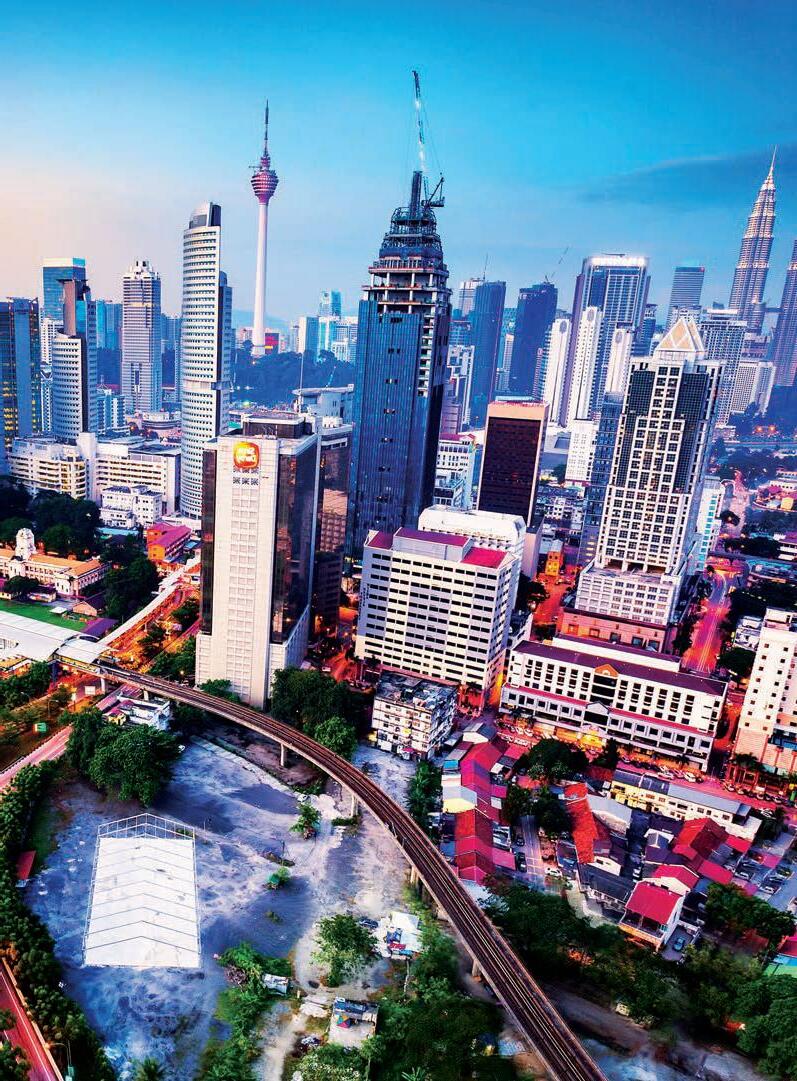
Dato’ Sri Zohari said he is pleased to report that “we are at par with developed countries”.
As an example, he cited the usage of Highway Information Modelling (HIM) software in implementing the 2,239km PanBorneo Highway, designed to increase connectivity in Sabah and Sarawak. HIM uses a combination of Geospatial Information System (GIS) and Building Information Modelling (BIM), which is meant to minimise errors and rework during construction.
Furthermore, mega infrastructure projects under the 11th MP are largely responsible for the 8.3% growth in the construction industry in 2017. Apart from the Pan-Borneo Highway, these include the East Coast Rail Line (ECRL), the High Speed Rail to Singapore (HSR) and Mass Rapid Transit project (MRT).
The Ministry’s key objective to “provide infrastructure in line with the people’s needs” fits in perfectly with the Budget 2018 theme of “prospering an inclusive economy, balancing between the worldly and hereafter, for the wellbeing of the people, towards the National Transformation 2050 (TN50) aspiration”.
Under the Fourth Thrust of the Budget, Driving Inclusive Development, the government has allocated RM6.6 billion for providing quality infrastructure. This includes, but is not limited to the following:
• Pan-Borneo highway
• People-centric projects
• Development of communication infrastructure
• Construction of roads in rural areas.
The Ministry of Works had done well in the six decades to develop the road/highway network to spur economic growth and growing car ownership. However, the national car ownership rate of 390 cars per 1,000 population is three times faster than the national population growth rate.
ArecentWorldBankGroupstudyindicatesthatresidents in Greater Kuala Lumpur spent over 250 million hours a year stuck in traffic, time that was estimated at 1.1% to 2.2% of Malaysia’s GDP in 2014.
It would be necessary to adopt smart urban mobility with the deployment of Intelligent Transport System (ITS) solutions to enhance transport performance in cities which, at the same time, would not exclude further construction of roads and other transport infrastructure. ITS solutions would save cost and reduce carbon emission.
Smartmobilityincludesintegratedtransportandlogistics, smart car parking (the ability to locate the best available street parking), priority at intersections and real-time journey planning based on cooperative communication. Providing real-time information before and during a trip will help individuals as well as increase the efficiency of the
transport system. Smart mobility is also about smart ticketing for easy payment for transport services across modes, car sharing services as well as Car2Car and Car2Infrastructure communication.
Smart mobility happens when people and the transportation systems are seamlessly connected and are interacting through innovative, state-of-the-art ITS technologies; that the local road engineering industry would need to address these future challenges.
Dato’ Sri Zohari said the government is cognisant of the challenges. Commuters in cities in particular, experience serious road congestion and spend an increasing amount of time commuting.
He agreed that a dynamic ITS system is needed to provide effective and efficient traffic and transportation managementforurbancommutersandrelevantagencies, with big data analytic tools deployed to improve the transportationsystem.Likemanygrowingcitieselsewherein the world, those in Malaysia face common public transport issuessuchasalackofinformationonroutes,schedulesand frequency as well as unstructured connectivity between the different modes of transport.
The concept of smart mobility was proposed in the 1990s, resulting in the ITS Strategic Plan (1999). Examples of ITS applications are Electronic Tolling Systems (TnG, Smart Tag), PLUS Traffic Monitoring Centre, Storm Water Management & Road Tunnel (SMART) and the Automatic Enforcement System (AES).
Today, the ITS Blueprint covers nine sectors and the Ministry’s focus is to “have good mobility of people” by determining how to leverage digital technology to provide the best ways to move people in urban areas in the Klang Valley. For example, the Electronic Tolling Collection (ETC) system is now 100% implemented nationwide. The next upgrade will be the implementation of a Multi Lane Free Flow (MLFF) system using Radio Frequency Identification (RFID) to allow toll collection without requiring vehicles to slow down.
Dato’ Sri Zohari said: “We want to raise the service level both at the highways and toll collection lanes or toll plazas. We’re almost there.”
The Ministry is also looking to incorporate technologies with ITS such as Weigh in Motion (WIM) to control rampant overloading of vehicles on roads in order to reduce maintenance and management costs of roads in the country.
The Ministry has recommended to the government an innovation of ITS – by developing an integrated and holistic approach to address the issues using big data. Essentially, it’s about adopting centralised traffic data management that is able to deliver sustainable and high quality services as well as to support the need for an efficient transportation network.
According to Dato’ Sri Zohari, the National Intelligent Transportation Management Centre (NITMC) is in the development stage and will be implemented once all the necessary infrastructures are streamlined. Its core business will be collection, integration and analysis of data. The integration of data will involve other stakeholders such as the City of Kuala Lumpur and various municipalities, the Land Public Transport Commission and toll highway concessionaires, entities which possess data from their own traffic centres.
Dato’ Sri Zohari said that with NITMC in place, the way forward will be to first form a public-private working alliance to successfully implement the Data Centre as a Service (DCaaS) for big data which contributes to an integrated and centralised urban traffic data management. DCcaaS will be able to provide real-time traffic information and enable smarter transportation networks that improve traffic operations and management.
Withreal-timecontrolandmonitoringaswellastheability toanalysemassivequantitiesofdata,thepublicwillbenefit. An intimate understanding of customer behaviour and journey plans will allow the authorities to plan for additional services on the required routes, to tailor communication to
individual riders to notify service changes and even provide target advertising.
In addition, DCaaS will provide customers with hosting needs for their data centres to be moved from onsite to offsite infrastructure, i.e. the cloud environment for better scalability, cost effectiveness and disaster recovery.
The second step is to connect people transportation services and vehicles with mobility of information and thirdly, to develop efficient and effective ways for mobility of people and the transport of goods. The fourth step is to collect, analyse and generate a wealth of realtime information on traffic and related transportation information.
The fifth and final step is to create an enormous opportunity for transportation data analytics and real-time decision-making for government agencies and private agencies, providing a collaboration platform for these players.
Dato’ Sri Zohari expects Malaysia to become a more active player as the key stakeholders in the ITS industry will beabletochooseinaconcertedmanneronhowtomove the industry forward. He said the Ministry has submitted a report to the Cabinet for the country to host ITS World Congress 2025, an event held in rotation between Europe, Asia Pacific and the Americas.

Enable smarter transportation networks that improve traffic operations & management Provide
Provision of offsite physical data centre facilities, infrastructure and services to clients In place at right time“Big Data’’ & “Cloud

















Ensure real time control & monitoring of traffic – benefits to public
Provides customers hosting needs for their data centre to move on-site infrastructure to off-site.

Sika have a full range of segmental bridge adhesives tested and approved to FIP standards, with the most extensive worldwide references of any manufacturer. Sika technicians could use and adapt this worldwide experience to support the application on site in Malaysia.
Sikadur®-31 SBA range of thixotropic, structural two part adhesive especially formulated for segmental bridge construction; available in different grades to suit different applications and environment conditions.
All grades present advantages such as the following:
• Meets and / or exceeds internal and national standards (FIP, BS, AASHTO, ASTM, etc)
• High strength and high modulus of elasticity
• Impermeable of liquid and water vapor
• No primer required





Consolidate and Centralized Information for End Users


Providing the required realtime public transportation and traffic information in ensuring the data will be integrated into a centralized data centre.

Providing the required realtime traffic information of major city highways in ensuring the data will be integrated into a centralized data centre

Assisted in formulating policies, monitoring and coordinating activities and programmes of various stakeholder providing the required real-time traffic information of Kuala Lumpur City and transportation related information.
For now, there are finer details to iron out and policies to streamline to make the ITS industry in Malaysia a success. Dato’ Sri Zohari stressed that “collaboration between stakeholders is crucial to make NITMC materialise”.
He said: “Integration and interaction between various stakeholders such as Ministry of Works, Ministries of Transports and other relevant ministries and agencies will pave the way to making NITMC a success. It’s not

Initiated for national urban transportation Improvement. Involved in providing and formulating policies, monitoring and coordinating activities and programmes of various stakeholders. Long-term partnership Private and Public Agencies

Involved in solution implementation for the Data Centre As A Service (DCaaS) and its infrastructure
just about the providers of infrastructure but also the behaviour of road users. We build infrastructure and the RoadTransportDepartmentisresponsibleforenforcement, ensuring everybody, all categories of road users, behave on the roads. We must all work together.
“We have to change the old ways of doing things. Today, people demand greater and better services. They travel around the world and compare how we do things here and abroad; this forces us as stakeholders to work together to deliver what customers want.”
On how to break the silo mentality among government agencies and transport operators relating to data sharing and coordinated project implementation, Dato’ Sri Zohari said the National Blue Ocean Strategy (NBOS) ensures that all the relevant ministries, agencies and the private sector canworktogetherandmakethebestuseoftheirresources.
“After 3½ years here, I have greater confidence about transforming the top management at the Ministry and agencies to deliver their KPIs. At the Ministry level, it’s about mutual respect when working with both Federal and state governments,” he said.
“I have great respect for the people, the professionals and technical staff. I’d say I’m here to provide the direction and we have to work together because we’re building the same nation.”
Dato’ Sri Zohari is experienced in implementing projects and is familiar with technical issues as before his present posting, he was with the country’s Economic Planning Unit (EPU) and the Public Private Partnership Unit (UKAS) in the Prime Minister’s Department.
There are over 1,000 personnel in the Ministry of Works under the Secretary-General, 800 in the Construction Industry Development Board (CIDB) and 450 in the Malaysian Highway Authority (LLM). There are about 10,000 in the Public Works Department (PWD), both under the supervision of PWD Headquarters and at state level which is directly overseen by state administrations.
Besides this, he said, policies and regulations regarding privacy of data sources, legal aspects in remote enforcement, standards and specifications will need to be reviewed.
Dato’ Sri Zohari said: “I tell the technical people to be relevant all the time. With Industry 4.0, the future is already here and there are even more advanced Building Information Management tools, such as the Building Information Modelling technology.”
On policies and measures undertaken by the Ministry of Works to plan, deliver and invest in infrastructure for sustainableurbantransport,hesaidthatforurbantransport, people have to recognise the fact that “we’re not going to build highways forever”. The country’s road network already spans approximately 144,000 km.
For sustainable urban transport, it is looking to adopt the Malaysia Green Highway Index for sustainability in road construction, while green procurement involves working with the Ministry of Natural Resource and Environment.
It is also working with the Harvard Business School on the potential of rating tools, while CIDB is working together with the Building Research Establishment United Kingdom (BRI UK) to develop Sustainable Infrastructure Indicators for Malaysia.
The Ministry of Works and the PWD have always been regarded as good training ground for new engineering
graduates to develop their career paths but Dato’ Sri Zohari said: “You have to remember the right-sizing of the civil service. There’s limited scope at present for young engineers to join the civil service. We are bringing our professionals abroad via CIDB and training our officers in project management and risk management to ensure their competency when it’s required.”
However, he added, there are training opportunities for young engineers under an initiative of CIDB to adopt the Industrialised Building System (IBS) technology, under the Construction Industry Transformation Programme (CITP). Increasing the scale of IBS adoption is under Productivity, the third thrust of the CITP.
As a result, IBS is being implemented in all government projects via the PWD and has taken a front seat in the Ministry’s policies and programmes. The effects are far reaching; the government is in the midst of amending Uniform Building By-Laws (UBBL) to make it compulsory for private sector projects to use IBS, hence opening up more opportunities on new segments/skills for engineers and technical professionals alike.
Under the newly-introduced IBS ecosystem, there are four training categories: Professionals, Contractors, Manufacturers/Distributors and Installers. CIDB has also developed an IBS Centre which provides facilities for budding construction-related entrepreneurs. In addition, there is a Vendor Development Program for youths who prefer a different route.
TheCITPwascreatedasablueprintbytheMinistryofWorksin “driving construction excellence together” in accordance with the 11th MP. There are four thrusts: Quality, Safety & Professionalism, Environmental Sustainability, Productivity and Internationalism.
Apart from driving up the scale of IBS adoption, it also aims to increase the productivity of workers by 2.5 times, bringing it up to US$16,500 per worker.
Under Environmental Sustainability, the Ministry is looking to adopt the Malaysia Green Highway Index for sustainability in road construction and a collaborative effort with the Ministry of Natural Resources & Environment is on-going to ensure green procurement.
Under Internationalism, the Ministry is looking beyond our shores and seeks to lead the construction industry locally and globally by ensuring that local companies can hold their ground against foreign competitors as well as be able to compete abroad.
Ultimately, one thing is clear: Through the CITP, the Ministry is committed to increase the people’s standard of living by embracing the 4.0 Revolution and adopting the latest technology in developing the nation’s infrastructure, a commitment that ties in neatly with the TN50 agenda to become a top 20 nation in economic development, social advancement and innovation.












Roads can promote economic growth and social integration but they can also initiate environmental, economic and socio-political harms. In many cases, these harms can be considerably minimised and the road benefits maximised through proactive planning by road engineers and effective Environmental Impact Assessments (EIAs).
We are living in an era of unprecedented road infrastructure expansion across the globe. The length of official roads has increased by 12 million kms worldwide since 2000, with a further 25 million kms expected to be built by 2050 (Dulac, 2013).
In the last decade (2002-2013), Malaysia has built 133,000 kms of official roads (ASEAN 2010, 2015), and there are ambitious plans for further road infrastructure expansion under the 11th Malaysia Plan (2016-2020) with a focus on rural connectivity.
Considering the contribution good roads can make to economic growth and rural connectivity, it is completely justifiable to expand the country’s network of roads. However, problems arise when road proponents are arguably unaware of the full extent of the risks that bad roads may pose to the economy, society and environment.
Moreover, in many cases, the inadequacies of EIAs – the only safeguard against potential environmental risks and to propose adequate mitigation and offset measures – means it has failed to expose the risks and thus do not allow road proponents such as engineers
and approving bodies to adequately respondtooracttominimisepotential risks.
In Malaysia, building roads is often a challenge due to factors such as the tropical climate, sporadically distributed human communities and exceptionally biodiverse and sensitive tropical forest landscapes.
The peninsula and Borneo are home to world renowned tropical rainforests. In particular, Borneo is one of only two places on the planet where rhinoceros, elephant and orangutan co-exist. The challenge to protect these landscapes is made even greater by the need for roads to support economic development which includes oil palm plantations, logging and mining. All these require roads to be laid in often remote, difficult terrain and, in many cases, through virgin rainforests.
Unfortunately, as we can see happening globally, the overestimation of road benefits often overshadows the estimation of road risks. Therefore, it is absolutely necessary to be able to adequately identify all the potential risks through effective EIAs and road infrastructure planning.
A badly-planned road can open a Pandora’s Box of environmental, economic and socio-political dangers (see Table 1 for selected examples, and Alamgir et al., 2017,foradetailed version). These risks vary across the full spatial and political spectrum, affecting local, state and national level governments. In some cases, these may even cross national boundaries.
The Pan Borneo Highway, for example, poses significant environmental risks, as it will dissect one of the two last remaining habitats of rhinoceros, elephant and orangutan.
Furthermore, road penetration into the rainforest will lead to human access and consequently increase risks of poaching, deforestation and degradation which will be likely to pushmanythreatenedfloraandfauna species to the edge of extinction.
The number of road kills will most likely increase, especially for large mammals, slow-moving wildlife and arboreal species which are being forced to traverse on ground (see Figure 1).
Social risks are already apparent under the current plan of the Pan Borneo Highway as evidenced by
Table 1: Selected examples of road development risks (details available in Alamgir et al., 2017; Laurance and Burgués-Arrea 2017; Laurance et al., 2009; Clements et al., 2014).
Threat to biodiversity - wildlife vehicle collision, habitat fragmentation, increased poaching, increased noise level effects on reproductive capacity of wildlife, barrier effects on animal migration.
Increased surface erosion and localised flooding
Landslides in steep terrain and impeded drainage in flatter terrain
Deforestation, illegal roads, illegal logging, and fires can increase
High construction cost due to tropical environments. In steep terrain, more cut and fill, tunnels and landslide mitigation measures will be required.
Flatter/swampy ground - these sections will require high road base and more culverts, bridges and drainage.
The real expenditure in road construction is often far less than that in the original budget due to corruption
Lack of investment for road maintenance – pothole and slumping (an example in figure 2 and 3) increase
Roads may become stranded assets due to rapid degradation by tropical climates (e.g. intense rainfall and resulting landslides) and lack of maintenance
Social disparity: Relatively few prosper from road development such as road proponents and social elite (e.g. resulting in higher land price) while many such as those who are forced to migrate, do not.
Influx of migrant workers often resulting in an increase in immoral activities such as prostitution and black market product usage
Increases in pathogens and diseases such as malaria and dengue fever
Threat to politicians – lack of community consultation and perceived unfairness can lead to social instability, lawsuits and litigation and protests
Increased effects on aquatic biodiversity and downstream community livelihood activities, e.g. pollution of fishing zones
If all risks are not discussed adequately during the planning process, the project may be delayed and costs increased

Roads can increase threats to indigenous culture through influx of non-indigenous land settlers, illegal colonisation and land appropriation, disruption of hunting by poachers and potential incursion of previously unknown diseases.
criticismslevelledbymanycivilsociety andcommunitygroupsinbothBorneo and Peninsular Malaysia.
Furthermore, with the uncertainty over the high levels of ongoing investment required for the future maintenance of the highway, it may fail to deliver the economic and social expectations, considering the difficult terrain it will need to traverse in both Sabah and Sarawak, and the intense seasonal tropical rainfall. If maintenance of the proposed Pan Borneo Highway is inadequate, it will rapidlybecomeaneconomicliability.
EIAs are intended to identify many of therisksandpotentialliabilitiesofroad infrastructureprojects,andtominimise such risks with suitable mitigation and offset measures. In Malaysia, an EIA had been a mandatory regulatory requirement for prescribed infrastructure projects since 1988

(DoE, 2007).Thishasseenenvironment impacts in Malaysia significantly reduced when compared to other comparable tropical countries.
However, many relevant road risks have not been adequately identified during the EIA process for road infrastructure projects, resulting in inadequate mitigation measures. This ineffectual assessment has been occurring due to a number of apparent inadequacies in the current process and requirement of EIAs (Yusoff and Hashim, 1996; Briffett et al., 2004) including spatial and temporal ignorance,conflictofinterestsandthe relaxation and flexibility of legislative requirements.
EIAs in road infrastructure projects in Malaysia often assess a narrow spatial and temporal scale that is inadequate to identify the impact on wildlife such as tigers and elephants, whose large home ranges and movementcorridorsmayoverlapwith planned road locations. Assessments also often focus on potential local impacts within a limited spatial scale and therefore fail to adequately assess the impact of development on the whole landscape.
For example, the current requirements for EIAs mean they rarely effectively identify the impacts on landscape level hydrological process and water flow, downstream wetland biodiversity and related livelihood activities (such as fishing) in downstreamhumancommunities.The
consequences become apparent when there are environmental pollution, clean water shortages, landslides occurrence or reduction in income.
EIAs surveys rarely, if ever, assess temporal variation in environmental communities. For instance, repeated surveysacrossalandscapeanddiurnal and seasonal period are necessary to identify rare and threatened species (Raiter et al., 2014). As mentioned, this practice is rarely evident in EIAs for road infrastructure projects in Malaysia or elsewhere in the tropics.
Few EIAs in Malaysia effectively assess indirect or induced and cumulative effects of a project, such as when a road opens a forested region to subsequent degradation. Access to these once intact areas can lead to significant degradation through encroachment, hunting, poachingandhabitatfragmentation.
For example, in Terengganu, 90% of snares and poaching camps in the forest were found within 5 km of the state route T156 (Clements et al., 2014). Such indirect impacts of road infrastructure expansion in forested areas are rarely identified during the EIA process. Furthermore, the EIAs requirement for small projects is often relaxed (i.e. not requiring community consultation and comments) or even deemed unnecessary for mini projects (DoE, 2007). However, the cumulative impacts of several small and mini projects may prove highly
detrimental to the landscape with regards to both natural ecosystems and human communities. In that sense, relatively few EIAs are sufficiently robust or adequate in scope.
As with most countries, the most striking feature of road development EIAs in Malaysia is the presence of “conflicts of interest”. This means that asmostEIAsarefundedbytheproject proponent, the consultancy firm may hesitate to conduct a stringent EIA if it believes this will result in it being blacklisted in future by other project proponents.
Project proponents usually have considerable resources and they push hard to get projects approved, regardless of EIAs. As such, consulting companies which deliver EIAs with very few mitigation measures despite the increased risks and lack of appropriate safeguards (Alamgir et al., 2017), will be the ones in high demand.
Moreover, the EIA process places the burden of proof on road opponents who rarely have detailed information about rare species, biological resources and ecosystem services needed to determine the actual environmental costs of roads (Alamgir et al., 2017).
In addition, the time allocation for public comments is often very limited and the requirement for a National RegistrationIdentificationCard(NRIC) number for online comments not only discourages local community input butalsopreventsinternationalexperts from providing useful and informed comments.
Often, road proponents also submit EIAs at a very late stage in the development process, sometimes even after a project has already started, although they are required to do so at the planning stage. This late submission can prevent the inclusion of effective comments or project modifications by exterior experts. For example, while the Department of Environment and Economic Planning Unit are usually quite stringent in incorporating public comments into development process and approvals, the late submission of
EIAs may prevent their inclusion and thus limit adequate modification and mitigation measures.
Many EIAs carried out for infrastructure projects in tropical developing countries are extremely superficial. A classic example can be seen in an EIA survey for a housing project in Panama’s suburban forests which reported only 12 common bird species. Subsequently, a bird expert identified121birdspeciesinthesame survey area within only two hours includingseveralrareandthreatened species (Laurance, 2007).
As in many other developing nations, some EIA surveys in Malaysia are conducted by inexperienced scientists who may not have the skills required for identifying rare and threatened species.
This trend of employing inexperienced scientists is also due to a shortage of skilled experts and the cost minimisation practices of EIA firms in order to remain competitive. Such inadequacies are compounded by the fact that EIA supervising and approving bodies, such as the Economic Planning Unit and the Department of Environment, often suffer from inadequate financial resources and their own lack of highly skilled personnel to effectively scrutinise the often complex EIAs for road infrastructure projects.
The deficiencies of EIAs for road projects increase the risk of environmental damage, social conflictsandlitigationwhichcanlead toprojectdelays,costoverrunsoreven project cancellation. However, many risks can be potentially minimised if road engineers are aware of them during the planning and road design phases. Further, the inadequacies in EIAs for road projects can be minimised through the incorporation of proactive planning and greater community engagement (details in Laurance et al., 2015) throughout the life of the project.
The inadequate consideration of risks in road infrastructure planning and the serious flaws in EIAs in road projects are not confined only to

developing nations but also in many developed countries.
However, in Malaysia, with the current rapid expansion of the road network, the pressure on policy makers by road proponents, extractive industries and multilateral lenders is many times higher than that by scientists and conservationists. The pressure would be greatly lessened through further financial resource provision and an increase in the use of highly skilled field personnel by the EPU and DOE. This would enable them to deliver the EIAs process more effectively through all stages, including the revision of current EIA requirements and processes, the effective monitoring practices of road developments and the strict enforcement of legislation. With such improvements, the producers of EIAs will be required to reach minimum satisfactory standards and this will very likely have positive impacts on the long-term environmental, economic and social outcomes of road developments in Malaysia.
[1] Dulac, J. (2013) Global land transport infrastructure requirements: Estimating road and railway infrastructure capacity and costs to 2050. International Energy Agency,Paris,France.p50.
[2] ASEAN (2010) ASEAN Statistical Yearbook 2010. The ASEAN Secretariat, Jakarta,Indonesia.p244.
[3] ASEAN (2015) ASEAN Statistical Yearbook2014.TheASEANSecretariat, Jakarta,Indonesia.p236.
[4] Alamgir, M. Campbell, M. J. Sloan, S. Goosem, M. Clements, G. R.
Mahmoud M. I. and Laurance, W. F. (2017) Economic, socio-political and environmental risks of road development in the tropics. Current Biology, 27: R1130-R1140.
[5] Laurance, W. F. and Burgués-Arrea, I. (2017) Roads to riches or ruin? Science, 358: 442-444.
[6] Laurance, W. F. Goosem, M. and Laurance, S. G. W. (2009) Impacts of roads and linear clearings on tropical forests.TrendsinEcology&Evolution 24: 659-669.
[7] Clements,G.R.Lynam,A.J.Gaveau, D. Yap, W. L. Lhota, S. Goosem, M. Laurance, S. and Laurance, W. F. (2014) Where and how are roads endangering mammals in Southeast Asia'sForests?PlosOne,9:e115376.
[8] DoE (2007) Environmental impact assessment (EIA): procedure and requirementsinMalaysia.Department of Environment (DoE), Ministry of Natural Resources & Environment, Malaysia. p 59.
[9] Yusoff S. and Hashim R. (1996) A case study on an environmental impact assessment in Malaysia. Transactions on Ecology and the Environment, 11: 161-169.
[10]Briffett, C. Obbard, J. and Mackee, J. (2004). Environmental assessment in Malaysia:ameanstoanendoranew beginning? Impact Assessment and ProjectAppraisal, 22 (3): 221-233
[11] Raiter, K. G. Possingham, H. P. Prober,S.M.andHobbs,R.J.(2014). Under the radar: mitigating enigmatic ecological impacts.Trends in Ecology & Evolution, 29: 635-644.
[12]Laurance,F.(2007).Roadtoruin.New Scientist.https://www.newscientist. com/article/mg19426075.600-forestdestruction-the-road-to-ruin/
[13]Laurance, W. F. Peletier-Jellema, A. Geenen, B. Koster, H. Verweij, P. Van Dijck, P. Lovejoy, T. E. Schleicher, J. and Van Kuijk, M. (2015). Reducing the global environmental impacts of rapid infrastructure expansion. Current Biology (25): R259-R262.
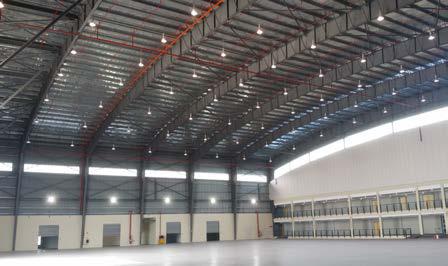
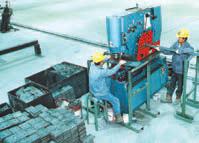
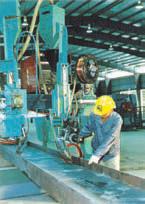


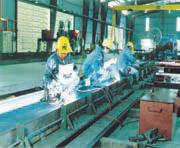


Authors' Biodata
Dr Mohammed Alamgir, is an environmental scientist and Postdoctoral Research Fellow at James Cook University,Australia. He is an expert on tropical road development and a member of the Alliance of Leading Environmental Researchers & Thinkers (ALERT).
Dr Mason J. Campbell, is a tropical rainforest ecologist and a Postdoctoral Research Fellow at James Cook University, Australia. He is an expert on road ecology and a member of the Alliance of Leading Environmental Researchers & Thinkers (ALERT)
Dr Sean Sloan, is a tropical land-change geographer and Senior Postdoctoral Research Fellow at James Cook University, Australia. His broad interests focus on long-term, large-scale transformation of the geography and management of tropical forest due to underlying human dimensions, including economics, land use, and governance.
Dr Wong Ee Phin, is an Assistant Professor at the University of Nottingham Malaysia Campus. A wildlife biologist, she is a co-investigator of Management & Ecology of Malaysian Elephants (MEME) and the Chapter Leader for the Society of Conservation Biology in Malaysia.
Prof. William F. Laurance, is an Australian Laureate, Distinguished Professor and the Director of the Centre for Tropical Environmental and Sustainability Science (TESS) at James Cook University, Australia. He is a global leader on road ecology, with over 40 years’ experience researching road infrastructure expansion in the tropics.
Title: Technical Talk on Geotechnical Challenges on Puah Dam, Hulu Terengganu Hydroelectric Project
27 February 2018
Organised by : Geotechnical Engineering Technical Division
Time : 5.30 p.m. - 7.30 p.m.
CPD/PDP : 2
Title: One-Day Seminar/Forum in Technical and Regulatory Issues in Mining Quarrying and Construction Including Tunnelling
1 March 2018
Organised by : Tunnelling and Underground Space Technical Division
Time : 9.00 a.m. - 1.00 p.m.
CPD/PDP : 6.5
Title: Technical Visit to a Rock Quarry in Semenyih, Selangor
3 March 2018
Organised by : Seniors Special Interest Group
Time : 9.00 a.m. - 1.00 p.m.
CPD/PDP : 3.5


Title: Talk on “Chemical Enhanced Oil Recovery (CEOR) Strategy and Approach - Offshore Peninsular Malaysia Case Study”
10 March 2018
Organised by : Oil, Gas and Mining Technical Division
Time : 9.00 a.m. - 11.00 a.m.
CPD/PDP : 2
Title: PRESTIGE TALK on "TN50-Green for Engineering Fraternity"
10 March 2018
Organised by : Civil & Structural Engineeering Technical Division
Time : 9.00 a.m. - 11.00 a.m.
CPD/PDP : Applying
Kindly note that the scheduled events are subject to change. Please visit the IEM website at www.myiem.org. my for more information on the upcoming events.
With deep regret, we wish to inform that Ir. Dalip Singh had passed away on 3 January 2018. On behalf of the IEM Council and management, we wish to convey our deepest condolences to the family.
- IEM Editorial Board

In conventional road designs, vehicles are given priority to ensure fast movement on the road. To achieve this, we have a clear demarcation between the space for vehicles and the space for pedestrians so that roads will be free of “obstacles”, allowing vehicles to move at the fastest speed possible.
While this may be the case for highways and expressways where the intention is fast mobility, it may not be so for roads in commercial or residential areas where the objective is accessibility. In these areas, there is a larger percentage of vulnerable road users, such as pedestrians and cyclists, to whom greater priority should be given.
In recent years, such awareness has been increasing with more attention being paid to the newyet-old concept of “shared space” or “shared zone”. This is an urban design concept where traditional traffic management systems (traffic lights, road signs, road markings and other conventional traffic elements) are removed, forcing vehicles and pedestrians to share the same road space (Hamilton-Baillie, B., 2008). The concept was first introduced in the 1970s by a Dutch traffic engineer, Mr. Hans Monderman (1945-2008), in the Netherlands (Project for Public Spaces, 2009). He thought that accident risks would be higher if there were more traffic management counter-measure strategies. However, by implementing shared space, individuals were empowered to take responsibility for their own behaviour and this would eventually reduce the number of accidents.
This happens when the awareness of risk to oneself or others means road userswouldbemorealertandbehave better when using the road space. Figure 1 shows an example of shared space street in United Kingdom.
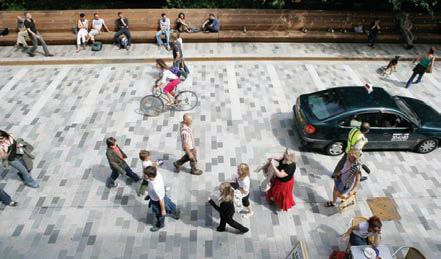
Today, many countries around the world, such as Germany, the United Kingdom, United States, New Zealand and Australia, have proper guidelines and rules on the implementation of shared space. The objectives are to provide a reference on how to implement shared space in an urban design with the aim to create a high performancespacethatimprovesthe interaction between vulnerable road users and vehicular traffic. A review of the guidelines in various countries shows that the following elements must be addressed in shared space design (Department for Transport, UK, 2011):
1. Vehicle Speed: High vehicle speed poses increased accident risk to road users. Thus, the recommended speed for vehicles
in the shared space zone is 30 km per hour or lower. This is important as it not only ensures the safety of road users but also encourages pedestrians to walk on the road.
2. Size of Carriageway: Wider roads or multiple-lanes will encourage drivers to move at higher speeds and this endangers other road users. The carriageway width is recommended at 5 metres for two-way roads and 3 metres for one-way roads. The narrow roads will also force drivers to slow down when another car is approaching. If the narrow road is designed with pedestrian infrastructure, drivers will become more aware and so drive at safe speeds since pedestriansarelikelytobepresent.
3. Paving: The pavement used in the shared space zone should

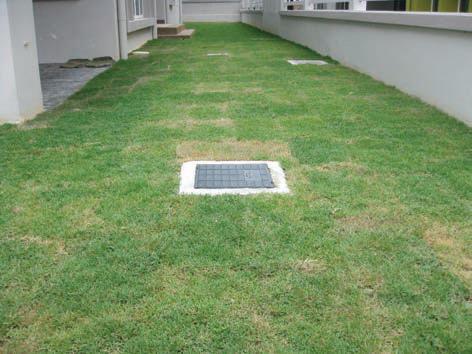


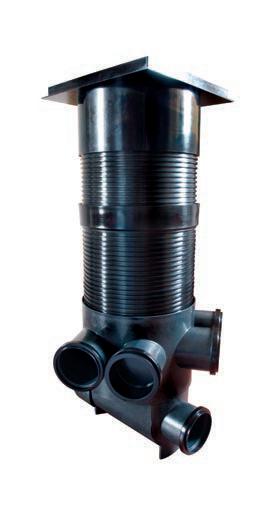

















be physically different from conventional roads. Interlocking concrete pavement, blocks or tactile pavement are preferred to remind drivers to slow down in the shared space zone.
4. Crossing: Traffic lights are usually employed to stop vehicles when pedestrians need to cross a road. In shared space, courtesy crossing is used. Courtesy crossing is designed with road pavement that’s at a level slightly higher than the road surface. The pavement surfaceisalsoofadifferenttexture (not only asphalt concrete), such as rubber rock or brick. Figure 2 shows an example of courtesy crossing in Chester, England. Courtesy crossings can also be provided in different forms, such as crosswalk with tonal contrast (different colour from driveway), crossing with bollards or by narrowing the road.
5. Urban Street Trees: The urban street tree was designed to be a part of shared space to provide a safer and more comfortable environment for street users. In shared space design, street trees are deployed to reduce vehicle speed by narrowing the road. The trees along the edge of the road also create a vertical wall, frame roads and act as a barrier to protect pedestrians. Street trees also filter sunlight, lower temperatures and provide fresh air, creating a comfortable environment for all. Figure 3 shows the urban street tree in a shared space zone.
6. Demarcation of Shared Space Zone: Shared zones should be different from a regular road environment and require a selfenforcing road environment. All shared zones must display regulatorysignagesandpavement

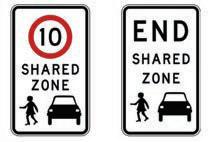
markers should be provided at the entry and exit areas. The entry sign should be provided on both sides of the road to remind drivers that they are entering a shared space zone where pedestrians and bicyclistsaregivenpriority.Figure4 showssomeofthesewarningsigns.
7. Removal of Conventional Traffic Management System: The shared space zone should be free of traffic signals. Instead, road users must take responsibility for themselves and become more aware of their surroundings. As a result, all vehicles and bicycles are forced to move at slower speeds and road users have to enhance their safety awareness, resulting in actualreductionsinthenumberof accidents (Hamilton-Baillie, 2008). Road curves should be removed but traffic calming devices such as road humps can either be removed or retained to help slow down vehicles.
With the implementation of shared space, it is anticipated that conventional traffic issues such as congestion, emission and pollution will be reduced. A study found that by removing traffic lights at junctions (and replacing them with roundabouts),vehiclecarbondioxide emission was reduced (Meneguzzer et al., 2017). The Australian study also found that there were no fatal crashes with speed limits of 30 km per hour and only 31 injury crashes reported on these roads in 2007 (Roads and Maritime Service, 2007). Shared space zones can promote a healthy, liveable city as they encourage more street activities
that will increase interactions between road users or residents in a neighbourhood. There will be increased flexibility in the use of the street environment for a diverse range of street activities such as dining and events. It can also create a more vibrant area to better support local businesses and attract investments. As such, it will contribute to the economic growth of the area or town.
However, shared space zones may result in some difficulties and discomfort for disabled people, especially the blind or partially sighted who usually depend on road kerbs for guidance. If these are removed, they may encounter problems in finding their way around.
Traffic lights with sound signals emitted are crucial traffic devices that guide the blind to cross the road safely. As such, there needs to be a path to guide them.
Others who may face challenges in shared space zones are the elderly or young children. Old folks with impaired vision, are weak of hearing and slow in responding may find difficulty when judging the distance of an approaching car or in estimating vehicle speed. As for younger children, they may not have had much experience in a road environment or they may ignore their safety when they play or run on the road.
Driver behaviour is a major factor that contributes to the success of shared space zones. Drivers with a good attitude, who are vigilant and who pay attention to the road environmentwillbeabletoensurethe safety of all road users.
New townships are mushrooming in Malaysia, especially in the Klang Valley. The authorities and developers are now focusing on developing sustainable or liveable cities with emphasis on street activities within the residential area. Shared space designs can be adopted as the reference when
designing the traffic network system in new townships.
The concept of shared space design can also be applied to busy parts of the city too. Bukit Bintang in Kuala Lumpur is a crowded commercial area bustling with retail shops, restaurants and shopping malls. There is high pedestrian traffic and sometimes there are street activities happening. Proper guidelines as mentioned earlier, can be used as a reference should the authorities decide to apply the concept to such areas or in future town or city designs.
Shared space design is one of the more important concepts in structuring sustainable or liveable towns and cities. The concept differs from the conventional road and traffic system design as it stresses on removing the separation of road users from vehicular traffic. Thus, it encourages greater interaction among road users. Driver behaviour is a key factor that determines whether shared space can be implemented successfully. As the shared space zone is free from any form of traffic control, drivers need to be more vigilant to reduce the risk of accidents. This is crucial and can only be achieved if drivers are well trained and informed about the concept.
[1] Brauer, W. (2014). The miracle of space. Smart magazine. <https://www. smart-magazine.com/en/the-miracle-ofspace/>Accessed09November2017.
[2] Department for Transport (2011). Local Transport Note 1/11: Shared space. The Stationery Office, United Kingdom.
[3] Hamilton-Baillie, B. (2008) Shared space:ReconcilingPeople,Plaesand Traffic. Built Environment, Vol. 34, No. 2, pp. 161-181.
[4] Meneguzzer, C., Massimuliano, G., Riccardo R., Gregorio, G., and Maria V.P. (2017). Comparison of exhaust emissions at intersections under traffic signal versus roundabout controlusinganinstrumentedvehicle. Transportation Research Procedia, Vol. 25, pages 1597-1609.
[5] Project for Public Spaces. (2009). Hans Monderman. <https://www.pps. org/reference/hans-monderman>. Accessed 26 March 2017.
[6] Roads and Maritime Service (2007). Road Safety: Making sure you stay safe on NSW roads. <http://www.rms. nsw.gov.au/safety/road-safety.html> Accessed 09 November 2017.
[7] University of Greenwich, London (2017) The Landscape: New Road, Brighton- A Shared Space <https:// thelandscape.org/2014/09/08/newroad-brighton-a-shared-space/> Accessed 09 November 2017.
Ir. Dr Khoo Hooi Ling, an Associate Professor at Universiti Tunku Abdul Rahman’s Department of Civil Engineering, obtained her PhD from National University of Singapore and Master of Engineering Science and Bachelor of Civil Engineering from Universiti Malaya. Author's Biodata
Error on Cover Story entitled “Issues and Challenges in Malaysian Maritime Industry“ published in JURUTERA December 2017 issue – 5th paragraph in Page 11.
It was wrongly written (printed) that 10 years ago, freight cost from Port Klang to Kota Kinabalu for a 20-footer container was RM120,000.00. In actual it should be RM1,200.00.
The error is much regretted.
- IEM Editorial Board

Except for the disabled, everyone walks. Even when we travel by car or motorcycle, we have to walk from the parking space to our office, home or other destination. If we take public transport (train or bus), we still need to walk to the train station or bus stop.


Walking is a good way to stay healthy as it can help reduce obesity, stress, blood pressure and heart diseases as wellasstrengthenbonesandmuscles.
However, in case of an accident, pedestrians are more at risk of injury and death than other road users. Thus, they are classified as vulnerable road users. In the event of a collision with a vehicle, the vehicle will directly impact the pedestrian’s body as he/ sheisnotprotectedbymetal(suchas the body of a car). Motorcyclist and cyclist are also considered vulnerable road users.
In Malaysia, pedestrians form the third highest fatality group after motorcyclists and car driver/ occupants. Figure 1 (for 10-year period, 2006-2015), shows that the totalnumberofpedestrianinjurieshas declined by 63%. Nevertheless, the numberofpedestrianfatalitieshasnot dropped significantly.
Figure 2 shows pedestrian casualtiesbyagedistribution.Children aged 6-10 form the highest group of casualties (fatality and injury), followed by young adults aged 26-30 and teenagers aged 11-15. Referring to [1], most pedestrian casualties are due to careless crossing on roads.
Young pedestrians are exposed to risks daily on their way to and from school. They tend to underestimate vehicle speed and the safety time gap required to cross the road safely. Thisiswhyweoftenseeyoungchildren dashing across the road despite oncoming traffic [2]. Without a traffic warden to guide and assist them in crossing the road, they take chances by crossing at will (see Picture 1).


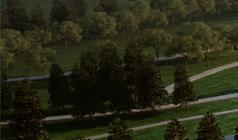





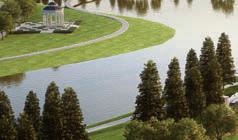


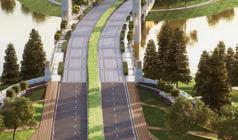



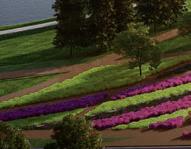














































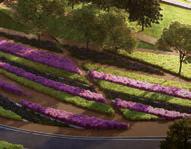

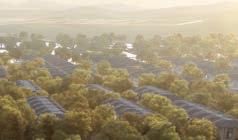

































































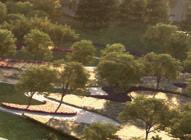



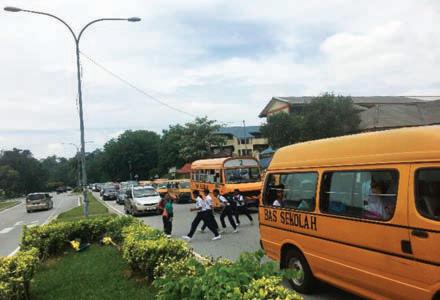
Promoting pedestrian safety requires an understanding of pedestrian crash risk factors which are not limited to the behaviour of pedestrians but are alsoinfluencedbyroadconditionand other road users, including:
1. VehicleSpeed: Vehiclesmovingat highspeedswillincreasetheriskof pedestrian fatality or severe injury in an accident. The risk increases by 50% when a pedestrian is hit by avehiclemovingat58kmperhour and, at impact speeds of 80km per hour, death is imminent [3].
2. Road Environment: On any road, you will find various types of road users sharing travelling space and moving in different directions and at different speeds, mass and capacities. The characteristic differences of these road users will create conflicting movements. Pedestrians (slow pace) require space that is segregated from motorised vehicles (fast pace). Providing proper facilities for pedestrians is necessary to avoid collision with vehicles.
3. Heavy Vehicles: When pedestrians are hit by a heavy vehicle (lorry, bus etc.), it is usually fatal. The risks are doubled when compared to
being hit by a light vehicle and 5 times greater than being hit by a motorcycle [4].
4. RunningTheRedLight: Atsignalised intersectionsormidblockcrossings, thecrashriskbetweenvehiclesand pedestrians is high when drivers violate red traffic lights [5]. This is mostly due to the aggressiveness of drivers when they run the red lights at high speeds. [6].
5. Driver Disrespect: Vehicle drivers may also be reluctant to give way to pedestrians. Sometimes, vehicles stop on the crosswalk, narrowing the walking path for pedestrians (see [7] for example). Because of this, pedestrians have to ‘bold’ to be able to cross the road[8].In[9],astudyprovedthat the drivers’ yield-to-pedestrian rates have a strong correlation to their speed. Community-based programmes can be an effective way to educate drivers on giving way to pedestrians [10].
6. Jaywalkers: These are pedestrians who cross outside of a crosswalk. Jaywalkingcreatesanunexpected situation in which drivers have to brake suddenly [11]. If they are unable to respond in time, an accident happens.
7. Pedestrian Violation: It is a huge risk for pedestrians to ignore traffic signals yet this is commonplace in many countries. Findings by previous researchers indicate that this may be due to several factors such as long waiting time, gender, age, time gap, to save time, the number of pedestrians waiting to cross and the presence of bus stops [12]–[14].
1. Improved Pedestrian Facilities
Facilities such as pedestrian crossings and footpaths provide dedicated areas for pedestrians to cross roads or walk. These facilities promote safety for pedestrians through space and time segregation from other road users. Providing proper pedestrian facilities as recommended [15] can help reduce the risk of accidents and increase walkability:
• Footpaths should be a part of every new roadway and must be provided on streets that do not have footpaths
• Footpaths should be provided on both sides of the road
• should allow a continuous accessible path of travel
• Be separated from vehicles by curb or buffer zone
• Have adequate width, with hard surfaces.
Pedestrian facilities must be well maintained and be free from obstructionssuchasstreetlights,trees, traffic signs and other decorative objects. It is recommended to adopt universal designs which can be used by everyone (including differentlyabled pedestrians) with ease. Those in wheelchairs will require curb ramps to access crosswalks and textured paving surfaces are important to act as a guide for the visually impaired. As for signalised crossing facilities, thetypeofsignalsetting(manualpush button or automatic) should depend on the location. At intersections with high pedestrian volume, automatic pedestrian signals can be used. For a midblock crossing with low pedestrian volume, a manual push button is
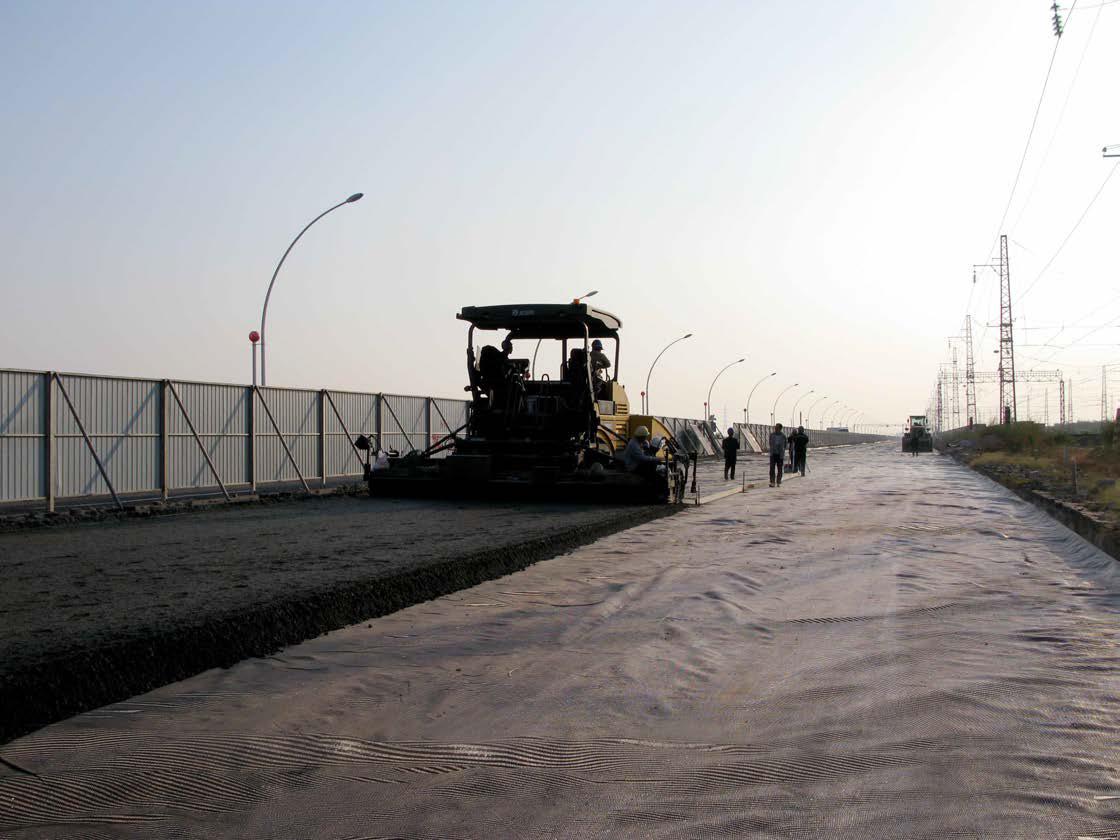


recommended as prolonged waiting without pedestrians crossing the road will result in drivers disrespecting the signal. On the other hand, missing pushbuttonswillresultinalongwaiting time for pedestrians who then choose to cross at will instead of waiting.
Basic pedestrian facilities at school areas should consist of footpaths, signs, road markings, traffic wardens and pedestrian crossings such as zebra crossing, signalised crossing and pedestrian bridge. If a pedestrian bridge is not provided, the visibility of the zebra crossing should be enhanced with a speed limit sign, school children crossing sign and the transverse bar to reduce the speed of approaching vehicles.
In addition, traffic calming treatments such as speed hump, speed table, transverse bar and textured pavement can be used to slow down vehicles. If there is adequate space, drop-off and pick-up zones can also be set up in schoolareas.Trafficwardensmustbe deployed to guide children exiting from vehicles to the footpath and to keep traffic moving smoothly and safely. A parking area is also necessary for parents and school transport vehicles waiting to pick up the children.
To further enhance safety, child safety zones should be introduced. All vehicles passing through should respect the set speed limit, especially during20minutesofpeaktime(before school starts and after dismissal). A drivercodeofconductisalsorequired to make sure drivers stop for school children entering or crossing the road in this zone.
Meanwhile, teachers can teach students about road safety through various activities. Teach them to wait, look and listen for traffic before they cross the road. Students should also be encouraged to relate to road safety in essays, speeches, slogans and poster drawing contests or photo exhibitions to reflect road safety in their daily routines.
Pedestrian safety depends on many factors, including drivers, road environment, vehicles and the pedestrians themselves. Making the road safer for pedestrians requires commitment from all parties concerned.Itistheresponsibilityofall. There should be a balance between providing good road infrastructureandthepracticeofusing roads correctly. At home, parents should practice safe crossing styles and teach their children the safest way to cross a road. Remind them to followtrafficrules,evenwhennobody is looking or there are no vehicles. Teaching them from young is the key to preventing accidents later.
[1] PolisDirajaMalaysia[PDRM],“Laporan Tahunan PDRM 2015 (Royal Malaysia Police Annual Report, 2015),” Kuala Lumpur,Malaysia,2015.
[2] D. F. Preusser, J. K. Wells, A. F. Williams, and H. B. Weinstein, “Pedestrian crashes in Washington, DC and Baltimore.,” Accid. Anal. Prev.,vol.34,no.5,pp.703–10,Sep. 2002.
[3] C. Kong and J. Yang, “Logistic regression analysis of pedestrian casualty risk in passenger vehicle collisions in China,” Accid. Anal. Prev., vol. 42, no. 4, pp. 987–993, 2010.
[4] H. Z. Dovom, M. Saffarzadeh, M. Z. Dovom, and N. Nadimi, “An analysis of pedestrian fatal accident severity using a binary logistic regression model,” ITE J., vol. 82, no. 4, pp. 38–43, 2012.
[5] R. A. Retting, J. F. Chapline, and A. F. Williams, “Changes in crash risk following re-timing of traffic signal change intervals,” Accid. Anal. Prev., vol. 34, pp. 215–220, 2002.
[6] P. Papaioannou, “Driver behaviour, dilemma zone and safety effects at urban signalized intersections in Greece,” Accidend Anal. Prev., vol. 39, no. 1, pp. 147–158, 2007.
[7] R. Hamidun, A. Roslan, N. Z. Harun, N. Megat Johari, A. Shabadin, and I. Siti Zaharah, “Evaluation of Midblock Crossing : Effect on Pedestrian and Vehicular Traffic,” 2017.
[8] A. Varhelyi, “Drivers’speed behaviour at a zebra crossing : A case study,” Accid. Anal. Prev., vol. 30, no. 6, pp. 731–743, 1998.
[9] T. Bertulis and D. Dulaski, “Driver Approach Speed and Its Impact on DriverYieldingtoPedestrianBehavior at Unsignalized Crosswalks,” Transp.
Res. Rec. J. Transp. Res. Board, vol. 2464, pp. 46–51, Dec. 2014.
[10]L. S. Sandt, S. W. Marshall, D. A. Rodriguez, K. R. Evenson, S. T. Ennett,andW.R.Robinson,“Effectof a community-based pedestrian injury prevention program on driver yielding behavior at marked crosswalks,” Accid. Anal. Prev., vol. 93, pp. 169–178, 2016.
[11] Y. Zheng, T. Chase, L. Elefteriadou, B. Schroeder, and V. P. Sisiopiku, “Modeling vehicle-pedestrian interactions outside of crosswalks,” Simul. Model. Pract. Theory, vol. 59, pp. 89–101, 2015.
[12]M. Brosseau, N. Saunier, K. Le Mouel, and L. Miranda-Moreno, “The impact of traffic lights on dangerous pedestrian crossings and violations : A case study in Montreal,” Transp. Res. Part F Traffic Psychol. Behav., vol. 21, pp. 159–172, 2012.
[13]G. Ren, Z. Zhou, W. Wang, and Y. Zhang, “Crossing behaviors of pedestrians at signalized intersections : Observational study and survey in China,” Transp. Res. Rec. J. Transp. Res. Board,vol.2264, no. 1, pp. 65–73, 2011.
[14]A. Tom and M. A. Granié, “Gender differences in pedestrian rule compliance and visual search at signalized and unsignalized crossroads.,” Accid. Anal. Prev., vol. 43, no. 5, pp. 1794–801, Sep. 2011.
[15]World Health Organization, “Pedestrian safety: a road safety manual for decision-makers and practitioners,” Geneva, Sep. 2013.
Author's Biodata
Dr Rizati binti Hamidun, is a research officer with Malaysia Institute of Road Safety Research (MIROS). She has a PhD in Transportation & Logistics from Universiti Teknologi Mara (UiTM).
Title: 2-Day Course on Implementing of KAIZEN for Chemical Products/process
7 - 8 March 2018
Organised by : Chemical Engineering Technical Division Time : 9.00 a.m. - 6.30 p.m. CPD/PDP : 13
Kindly note that the scheduled events are subject to change. Please visit the IEM website at www. myiem.org.my for more information on the upcoming events.




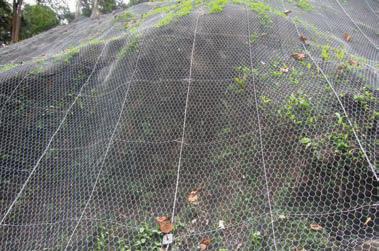







We are a supplier of high quality geosynthetic products used for soft soil stabilization, slope reinforcement, coastal erosion protection, river bank protection, landfills, drainage, road and railway construction.






NWe also provide design, specification, bill of quantities, cost estimate and drawings free-of-charge. Lee Hui Seng (012-3293378) Fazrol (012-3163341)




by Ir. Shum Keng Yan
ow that I caught your attention with the headline, let us revisit the Urgent Repair case study (October 2017). We will apply the Significance: Timing: Consistency on the Consequences. I will mark them with + (plus) or – (minus).
1. No one got hurt.
Significance: (+) Positive impact to the person as it feels good not to be hurt.
Timing: (+) Felt immediately.
Consistency: (+) Well… almost always.
2. The production team is pleased with the repair.
Significance: (+) Positive impact that the production team (internal customer) is pleased.
Timing: (+) Felt immediately.
Consistency: (+) Which production team is not pleased EACH time the repair is done fast?
3. The repair job was done in a more comfortable environment.
Significance: (+) Positive impact as the person feels comfortable. Timing: (+) Felt immediately.
Consistency: (+) Positive again as it is consistently comfortable.
4. It was much faster.
Significance: (+) Positive impact as the job is done.
Timing: (+) Again felt immediately.
Consistency: (+) The rewarding feeling is consistent each time.
5. The technician team is happy.
Significance: (+) Positive impact felt by the person from the team (acceptance).
Timing: (+) Another immediate “feeling”.
Consistency: (+) Every maintenance team is happy when the job is completed!

In many cases, there will not be any significant hurt in carrying out an unsafe act resulting in immediate gratification which is consistently reinforced. Thus by behaving unsafely, it is inherently rewarding and self reinforcing!
Thishasgottostop!Ifyouhaveanyideas,feelfreetoshareyourPlusand Minus at: pub@iem.org.my.
The strength to do what is right when it seems easier not to, makes the difference!

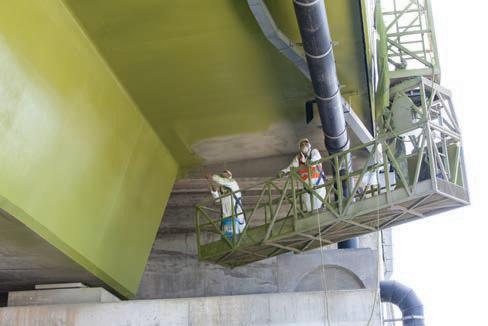









This new road alignment bypasses a section of Route 1 Federal Road that goes through busy Rawang town in Selangor. The 9km highway with an elevated 2.7km stretch and 58.2m-high pillar structures, is currently the tallest highway in the country.
The bypass cuts through Hutan Simpan Kancing,ahillyheritagestateparkpopular with nature lovers and eco-tourists. This unique bypass was constructed using the Movable Scaffolding System (MSS) which minimised the use of excessive heavy machinery, wildlife and the ecosystem remained relatively unaffected
Driving through the elevated Rawang Bypass is a scenic experience, especially with the misty surroundings in the early morning or after the rain.

reported by


The Institution of Engineers Malaysia (IEM) and the Malaysian Institute of Road Safety Research (MIROS), signed a Memorandum of Understanding (MoU) on 11 August, 2017, at the Ministry of Transport in Putrajaya.TheMoUwassignedbyIEM President Ir. Tan Yean Chin and MIROS Director General Professor Dr Wong Shaw Voon.
The signing was witnessed by Transport Minister Dato' Sri Liow Tiong Lai. Also present were Ir. Yap Soon Hoe (IEM Honorary Secretary), Ir. Ong Ching Loon (IEM Vice President/Chairman of Standing Committee on Corporate Affairs), Ir. Richard Wong (Chairman of Highway and Transportation Engineering Technical Division), Ir. Gunasagaran Kristnan, Ir. K.K. Chin and Ir. Wong Chee Fui.
Earlier, the IEM delegation paid a courtesy visit on Dato' Sri Liow before the signing ceremony.
The MoU paves the way for formal programme collaboration between IEMandMIROS. Areasofcollaboration identified are:
a) RoadSafetyAuditorAccreditation.
b) Road traffic safety technology and facility.
c) Road traffic safety assessment and audit.
d) Road traffic safety management system.
e) Roadtrafficsafetycountermeasure.
Collaboration activities include:
a) Regular mutual exchange of project catalogue and annual reports.
b) Regular mutual visits and taking turns to host the annual workshop/ seminar.
c) Mutual exchange of personnel to participate in selected projects.
Through the MoU, IEM and MIROS will foster a relationship that will promote intellectual exchanges and increase cooperation and collaboration in research and development efforts.
The IEM Highway and Transportation Engineering Technical Division will be collaborating with MIROS to achieve its objects.

reported by

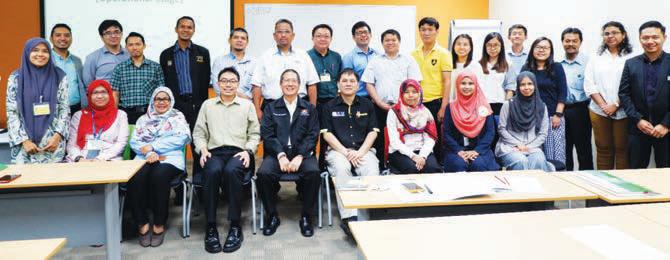
The Highway & Transportation Engineering Technical Division (HTETD) and the IEM Penang Branch jointly organised a 1-day seminar on Road Safety Audit (RSA) & Traffic Management Plan (TMP) on 24 November, 2017, at the Penang Skills Development Centre (PSDC), Penang.
The speaker was Ir. Richard Wong, a veteran JKR-accredited road safety auditor.The30participantscomprised engineers from the Penang State Government, Majlis Bandaraya Pulau Pinang (MBPP) and Majlis Perbandaran Seberang Perai (MPSP), developers, contractors, consulting engineers and some academicians.
Ir. Wong began with an overview of the current road safety situation
in Malaysia, recommendations on road safety and design, objectives of conducting road safety audit and technical guidelines published by JKR which are adopted by design engineers and road safety auditors.
He explained the 5 stages in the development of a road project when it was most appropriate to carry out a Road Safety Audit (RSA).
1. Feasibility and Planning Stage.
2. Draft (Preliminary) Design Stage.
3. Detail Design Stage.
4. During Construction/Pre-Opening Stage.
5. After Construction/Operational Stage.
Stage 1: Feasibility & Planning
At Stage 1, the auditor looks into the General Traffic Management – how
motorists can safely enter and exit, junction control and the use of oneway or service roads. The safety of more vulnerable users (motorcyclists and pedestrians) are also given due consideration. In the Road Evaluation Criteria of alternative roads or options, road safety performance is also weighed and audited as well as design criteria, construction cost, socio-economic and environmental issues.
Stage 2: Draft (Preliminary) Design
In Stage 2, checks are made on preliminary engineering drawings for the combination of horizontal and vertical profiles to ensure there are no obstructions to sight distance, appropriate cross sections of widths of lane, median, marginal strip,
shoulders, motorcycle lanes, footpaths and Right of Way. Lane continuity and balance as well as avoidance of trap lanes are important road safety issues to look into. All major junctions should have appropriate acceleration and deceleration lanes.
In Stage 3, all outstanding road safety issues identified in Stage 2 have to be addressed or rectified. After road safety decisions are made and agreed upon by the designer, auditor and authorities, the designer will come up with a detailed engineering design that includes detailed cross sections, profiles, intersections, interchanges, traffic signs, road markings, safety barriers, etc. The Auditor will audit these to the best road safety guidelines and requirements.
The Traffic Management Plan (TMP) falls under Stage 4. Before any road constructionworkiscarriedout,thecontractorwillneedtoprovidetheTraffic Management Plan (TMP). The road safety auditor then audits the TMP for Advance Warning Signs and Protection to both road users and construction workers (during construction).
Stage 4 also includes an audit at about 50% completion and an audit before the road opens for traffic or pre-opening. They will check if the road hasbeenconstructedaccordingtodesignandifthereisanyunforseenroad safety issue on site and mitigating factors such as traffic signs, road markings and safety barriers will be considered.
Stage 5 is carried out during the Defect Liability Period at 3-6 months after opening, to check on the drainage, road defects and how the trees have matured to see if they are obstructing traffic or street lighting or if they are a road hindrance.
Before the seminar ended, Ir. Wong gave the participants some parting words.Hesaidthatwhileengineers,contractors,auditorsandtheauthorities do their best to ensure road safety, the environment and design contribute insignificantlytoroadaccidents.Thegreatestcontributorstoroadaccidents, he stressed, are human behaviour and attitude.
The seminar allowed participants to learn and understand Road Safety Audit,theengineeringdesignprinciplesbehindit,andthegoodengineering designsandpracticeswhichweasengineerscanadoptinmakingMalaysian roads safer for users.












reported by

The Malaysian government is concerned that school students today are steering away from science subjects and choosing careers in arts instead. Studies show that only 20% of students choose to enroll in the science stream, with the result that science-related courses in local universities are not attracting the number of students needed. This trend, if not checked, will prove detrimental to the country’s future technical development.
To address the problem, the Ministry of Education Malaysia (MOE) and Malaysia Digital Economic Corporation Sdn. Bhd. (MDEC) have jointly launched education initiatives called STEM (Science Technology Engineering Mathematics). IEM is in collaboration with MDEC to become the digital maker hub for Petaling Jaya.
IEM is at the forefront to promote the advancement of science and technology to cultivate quality STEM activities for school students, especially in physical computing, software development and engineering design.
To begin, ICT Special Interest Group organised a series of Junior Digital Classes for Primary School students to explore Microduino basics and to build up their familiarity with Microduino mCookie modules, sensors and trinkets. Microduino mCookie is Arduino-compatible open source electronic hardware for makers,designers,engineers,students
ICTSIG Junior Digital Class (November, 2017) - STEM Fun Learning
Introduction: Prototyping of Arduino application using Microduino #1
- Postponed from 17 Nov, 2017
Date/Time: 24 November, 2017 (09:00 a.m. - 12:00 p.m.)
Venue : YES Room, Bangunan Ingenieur
Speaker : Ir. Amir Hussein
CPD/PDP : N/A
Remark : 16 Participants
School Name:
• SMK Cyberjaya Persiaran Fauna 2, Zon Flagship 2, 63000 Cyberjaya
• SMK Seksyen 4 Kota Damansara
• SK Cyberjaya
ICTSIG Junior Digital Class (November 2017) - STEM Fun Learning
Introduction: Prototyping of Arduino application using Microduino #1
Date/Time: 10 November, 2017 (09:00 a.m. – 12:00 p.m.)
Venue : YES Room, Bangunan Ingenieur
Speaker : Ir. Amir Hussein
CPD/PDP : N/A
Remark : 16 Participants
School Name: Sekolah Kebangsaan Putrajaya Presint 18(1)
ICTSIG Junior Digital Class (November 2017) - STEM Fun Learning
Introduction: Prototyping of Arduino application using Microduino #1
Date/Time: 10 November, 2017 (02:00 p.m. – 05:00 p.m.)
Venue : YES Room, Bangunan Ingenieur
Speaker : Ir. Amir Hussein
CPD/PDP : N/A
Remark : 15 Participants
School Name : Sekolah Kebangsaan Assunta 1
ICTSIG Junior Digital Class (November 2017) - STEM Fun Learning
Introduction: Prototyping of Arduino application using Microduino #1
Date/Time: 08 November 2017 (02:00 p.m. – 05:00 p.m.)
Venue : YES Room, Bangunan Ingenieur
Speaker : Ir. Amir Hussein
CPD/PDP : N/A
Remark : 15 Participants
School Name: Sekolah Kebangsaan Assunta 1

and curious tinkerers of all ages. It is powerful, small, LEGO® - compatible and also magnetically stackable. Students learnt the basics of circuitry, electronic controller, power source, mechanical sensor (switch), light sensor, sound sensor (microphone) and colour LED trinket to construct energy efficient light prototypes. Students tried out different sensors and trinkets configurations and operation parameters to modify the energy efficient light prototype for different types of real world application. This project mover was Ir. Amir Hussein bin Jaafar.
1. An introduction to IEM and IEM’s role in promoting the engineering profession.
2. Explanation on STEM education initiatives to school children and the digital hub formation in IEM.
3. To give an overview with lots of examples of STEM.
4. Prototyping of Arduino application using Microduino #1 –
5. Exploring Microduino basics, circuitry, power supply, electronic components and to build up familiarity with the Microduino modules.
6. Introducing various sensors, LED and trinkets and build energy efficient lighting control.
7. Introduction to software simple programming technique.
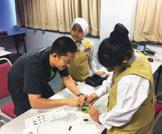

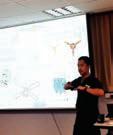


Authorised Publisher: The Institution of Engineers, Malaysia (IEM) - JURUTERA
Explore our full set of Professional and Integrated PUBLISHING MANAGEMENT SERVICES:
» Project Management
» Creative Management
» Ad Space Management
» Mailing Management
» Print Management
• Annual Reports
• Booklets • Brochures
• Buntings • Business Cards
• CD / DVD Replications
• Calendars • Cards & Invitations
• Certificates • Custom Printings
• Envelopes • Folders
• NCR Bill Books • Notepads
• Leaflets • Letterheads Posters


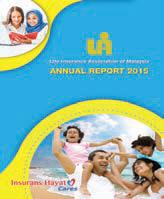




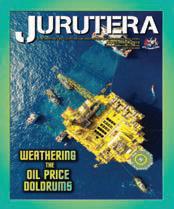


































We are pleased to inform that IEM will be holding the 59th Annual Dinner and Awards Night 2018 on 21 April, 2018. Dimension Publishing has been appointed to put together the Annual Dinner Programme Book which will be circulated to all 1,200 guests on that night at Sunway Resort Hotel & Spa, Petaling Jaya
It is an annual event organised by IEM to present awards to winners of projects and to announce the new committee for year 2018/2019. Special guests of honour will be invited to officiate at the event.
We are now calling for interested advertisers to book their preferred advertising position in this programme book. Below please find the advertising rates for your immediate action and reply. We hope to hear from you soon before the closing date on 19 March 2018


ANNUAL DINNER AWARDS NIGHT &
2016 Programme Book

Book Size: 210mm(W) x 285mm(H). Please provide extra 6mm for bleed area on all 4 sides
Printing Specifications : 230gsm art card (Cover), 105gsm art paper (Text), 4C + 4C, Staple binding, UV varnish on Cover
Quantity: 1,200 copies
Advertisement Format : High resolution PDF file, with crop marks, bleed area, text being outlined
Deadlines : : 19 March 2018 (Mon) (Ad Booking) 26 March 2018 (Mon) (Artwork Submission)
Kindly tick in the relevant bracket. IEM reserves the right to edit, revise or reject any advertisement deemed unsuitable or inappropriate. The final print-ready artwork to be furnished by advertisers.
President’s Message2,800
Facing Past Presidents List2,800
Facing Inside Back Cover2,800
Run-On-Page (ROP)1,900
Double Page Spread (DPS)4,500
Remarks:
• Space availability is subject to booking on first-come-first-served basis
Company logo will be appeared in the Acknowledgement Page in both IEM Dinner Programme Book and JURUTERA May 2018
• Advertising rate is subject to 6% GST. Please take note that the advertising rates shown above exclude the 6% GST
• Prices shown above exclude 15% Advertising Agency commission
• Any cancellation after signing the Advertising Contract shall result in a 50% penalty charge
• Payment term: 14 days upon invoicing
Name of Company:
Company Stamp & Authorized Signature:
Date:
Contact Person(s):
Email Address:
For advertising enquiries, please contact: DIMENSION PUBLISHING SDN. BHD. (449732-T) Level 18-01-03, PJX-HM Shah Tower, No. 16A, Persiaran Barat, 46050 Petaling Jaya, Selangor. Tel: +603 7493 1049 Fax: +603 7493 1047 Email: info@dimensionpublishing.com www.dimensionpublishing.com

Iwas invited by the Petronas Methanol Plant in the Federal Territory of Labuan to be a guest speaker at its annual innovation celebration. As the event was held during the school holidays, I brought myfamilyalongandextendedmystay after the event.
My family and I ventured around Labuan Island, also popularly known as the Pearl of Borneo. It is a peaceful place surrounded by beautiful beaches, carpeted with charming tropical trees and houses a few interesting sites such as the Chimney Tower, a water village (Kampung Patau Patau) and Malaysia’s largest World War II cemetery where 3,908 Australian, British and Indian soldiers were buried. I visited all these sites but I found the Chimney Tower particularly intriguing.
It is located in Tanjung Kubong, in north east tip of Labuan Island. This area is also known as Coal Point during the British occupational period although locals refer to it as punil. The Chimney Tower is a rectangular tower of red bricks, with two arched entrances at its base in the north and south. There is a decorative frieze at the top. Each archedentranceis2.2metreshighand functions as a wind breaker to protect the tower from strong winds.
Standing at 32.5 metres tall and facing the South China Sea, the tower is made with over 23,000 pieces of red
bricksimportedfromEngland.The architecturaldesignandthebrick layering work are influenced by the British style. There are 12 layers of bricks beneath the ground and the tower sits firmly on limestone rock, containing highly concentrated kaolin or porcelainclaywhichiscompact andprovidesasolidfoundation.
The tower was constructed around 1900 when coal mining activities were at its boom in Labuan (1847 to 1911).
There are several theories about the exact function of the tower. Initially, because of its location, it was thought to be a ventilation shaft for an underground coal mine. However this suggestion was dismissed after excavation work at the site failed to uncover any evidence of mining activity. It was also believed to be a lighthouse to alert passing ships because of its strategic location on high ground, close to the open sea and the presence of Raffles Port nearby.
An Australian, who conducted in-depth research, suggestedthatthetowerwas built to be a smoke stack for brickmaking as large quantities of bricks were in


Yes! I would like to be a subscriber of The Institution of Engineers, Malaysia’s publications
Name: _________________________________________________________________________________________________________
Mailing Address:_________________________________________________________________________________________________
Country: ________________________
Company/Institution:______________________________________________________________________________________________
Title: ____________________________________________________________________________________________________
Telephone No: _________________________ Fax: _________________________ Email: _________________________________
New Subscriber Renewal
Please commence my subscription from: _________________________(month/year) Signature: _______________________________
To start your subscription of IEM’s publications, complete this form and mail it back to the address below. For faster processing, fax it to: +603 7493 1047. Thank you.
What is your primary job title?
Corporate Management (including chairman, president, proprietor, partner, director, vice president, general manager, division manager, import/exportmanager,othercorporatetitle)
Management (including project/contract/equipment/service/transport districtmanager,clerkofworks,othertechnicaloroperatingmanager)
Engineering/Design (including chief engineer, chief designer, civil/ highway/mechanical/planningengineer,otherengineering/designtitle)
Buying/Purchasing (including chief buyer, buyer, purchasing officer, otherbuying/purchasingtitle)
Titles allied to the field (architect, consultant, surveyor, research and development professor, lecturer, supervisor, superintendent, inspector orotheralliedtitle)
Others(pleasespecify)____________________________
What type of organisation do you work in? (Tick one box only)
Contractor
Sub-contractorspecialist
Designandbuildcontractor
Consultingengineering/architectural/quantitysurveyingpractice
Mining/quarrying/aggregateproductioncompany
Petroleumproducer
International/nationalauthorities
National/regional/localgovernment
Publicutilities(electricity,gas,water,deckandharbour,other)
Manufacturer
Distributor/importer/agent
Constructiondepartmentoflargeindustrial/Commercialconcern
Association/educationestablishment/research
Constructionequipmenthire/rentalcompany
Project/constructionmanagementconsultancy
Others(pleasespecify)_______________________________
What are the main activities of your organisation? (Tick all that apply)
Constructions of: Manufacturer of:
Roads/bridges

Constructionequipment
Dams/reservoirs/irrigation Cement
Harbours/offshorestructures Otherconstructionmaterials
Foundations/tunnels Distribution
Pipelines/refineries Construction equipment
Structures/steelwork Constructionmaterials
Building(commercial,industrial) Hire/rentalofconstructionequipment
Housing Design
Constructionmanagement Earth-moving/opencastmining Deepmining Aggregateproduction
Others(Pleasespecify)_________________________________________
Rate (Please tick)
RM360.00 -12issuesofJURUTERA
RM84.00 -2issuesIEMJournal(Half-yearly)
Terms and Conditions:
1) Thesubscriptionistobeprepaid.
2) Pleasemakechequepayableto Dimension Publishing Sdn. Bhd.
3) Subscriptionsarenotrefundable.
4) Magazine/swillbesenttothemailingaddressgiven.
5) Studentsareentitledfora20%discountfromtheabovesubscriptionrate.
6) Students must submit a photocopy of the student identification card together withthepayment.
7) Theaboverateisinclusiveofdeliverychargesandapplicablein Malaysiaonly.
8) Additionaldeliverychargeswillapplytooverseassubscribers.
For subscription enquiries, please contact +603-7493 1049 or email to info@dimensionpublishing.com
KepadaSemuaAhli,
Tarikh::23Januari2018
Berikut adalah senarai calon yang layak untuk menduduki TemudugaProfesionalbagitahun2017.
Mengikut Undang-Undang Kecil IEM, Seksyen 3.8, nama-nama seperti tersenarai berikut diterbitkan sebagai calon-calon yang layak untuk menjadi Ahli Institusi, dengan syarat bahawa mereka lulusTemudugaProfesionaltahun2018.
Sekiranya terdapat Ahli Korporat yang mempunyai bantahan terhadap mana-mana calon yang didapati tidak sesuai untuk menduduki Temuduga Profesional, surat bantahan boleh dikemukakan kepada Setiausaha Kehormat, IEM. Surat bantahan hendaklah dikemukakan sebulan dari tarikh penerbitan dikeluarkan.
Ir. Yap Soon Hoe Setiausaha Kehormat, IEM
PERMOHONAN BARU NamaKelayakan
KEJURUTERAAN AWAM
NOR AZLINA BINTI NOOR RASHIDBE HONS (UTM) (CIVIL, 2002)
SYARIFULANUAR BIN MOHAMED NASIR BE HONS (UTHM) (CIVIL, 2007)
MINJO AK SIMANDING BE HONS (UNIMAS) (CIVIL, 2002)
LIM MIN KHONGBE HONS (LEEDS) (CIVIL & STRUCTURAL, 2006)
AMIRUL HAIKAL BIN AZIZANBE HONS (UKM) (CIVIL & ENVIRONMENTAL, 2007)
KEW CHUEN FATTBE HONS (UKM) (CIVIL & STRUCTURAL, 2013)
LIM HAN JIANBE HONS (UTAR) (CIVIL, 2011)
ONG KEE SEONGBE HONS (KLiUC) (CIVIL, 2010)
IZWAN BIN MASHURIBE HONS (UNITEN) (CIVIL, 2006)
ABD. RASHID BIN SAMAN @ OTHMAN BSc (SEOUL NATIONAL) (CIVIL, 1994)
AINUL JAMAL B. MUSABE HONS (UiTM) (CIVIL, 2009)
IVAN LOW KOK SIONGBE HONS (UKM) (CIVIL & STRUCTURAL, 2005)
NG BOON CHAIBE HONS (MALAYA) (CIVIL, 1997)
WONG KUOK YONG BE HONS (MALAYA) (CIVIL, 1998)
LEE SUN CHAI BE HONS (SOUTHWEST LOUSIANA) (CIVIL, 1983) ME (SOUTHWEST LOUSIANA) (CIVIL, 1985)
GHANA SEKARAN A/L DORAISAMYBSc HONS (STRATHCLYDE) (CIVIL, 1984)
AHMAD SAFUAN BIN A RASHID*BE HONS (UTM) (CIVIL, 2004)
AZMI BIN AMAT BE HONS (UNIMAS) (CIVIL, 1999)
MOHAMMAD FADZIL BIN AHMAT
RUSLAN BE HONS (UiTM) (CIVIL, 2005)
MOHD NASIR BIN KAMAROL ZAKIBE HONS (UTM) (CIVIL, 2008)
SABIRA BINTI ABDUL SAMAD BE HONS (UiTM) (CIVIL, 2006) MSc (UiTM) (GEOTECHNICAL, 2016)
SUMATHI A/P SUBRAMANIAM BE HONS (UTP) (CIVIL, 2007) ME (UTM) (GEOTECHNICS, 2016)
YUNIKA KIRANA BINTI ABDUL KHALIK BE (UMP) (CIVIL, 2009) MSc (UiTM) (GEOTECHNICAL, 2016)
KEJURUTERAAN ELEKTRIKAL
CHONG KOK LEONGBE HONS (UNITEN) (ELECTRICAL & ELECTRONICS, 2005)
ANUAR BIN IBRAHIMBE HONS (UiTM) (ELECTRICAL, 2010)
ALFISYAHRIN BIN ABDULLAH BE HONS (UiTM) (ELECTRICAL, 2010)
UMI NADIA BINTI MARTAZABE HONS (UNITEN) (ELECTRICAL POWER, 2009)
YOGENDRA BALASUBRAMANIAMBE HONS (UNITEN) (ELECTRICAL & ELECTRONICS, 2009)
MOHAMAD FIRDAUS BIN ABASBE HONS (UTM) (ELECTRICAL, 2008)
SHAHRULNIZAM BIN SALIHINBE HONS (UiTM) (ELECTRICAL, 2007)
MOHD KAMARUL HAFIZI BIN
BAHAUDIN BE HONS (KUTKM) (INDUSTRIAL POWER, 2006)
DOUGLAS TAN BE HONS (UTP) (ELECTRICAL & ELECTRONICS, 2007)
ZALINA BINTI SAMSUDINBE HONS (UPM) (ELECTRICAL & ELECTRONICS, 2002)
NOR ATIKAH BINTI MOHD SABKIBE HONS (UKM) (ELECTRICAL & ELECTRONIC, 2007)
MOHD HAFIZ BIN BOTA’BE HONS (UTM) (ELECTRICAL, 2007)
MOHD HANIFF BIN AHMADBE HONS (UiTM) (ELECTRICAL, 2010)
SITI FARADILAH BINTI AMIRUDDINBE HONS (UNITEN) (ELECTRICAL & ELECTRONICS, 2007)
NOR HIDAYAT BIN MOHAMEDBE HONS (UTM) (ELECTRICAL, 2014)
MUHD KAMAL NIZAM BIN CHE AB RAZAB BE HONS (UMS) (ELECTRICAL & ELECTRONIC, 2007)
FARAH HANUM BINTI OMARBE HONS (UTM) (ELECTRICAL, 2006)
NIK MOHD FAISAL IDHAM BIN NIK MUSTAPHA BE HONS (UTM) (ELECTRICAL, 2010)
MUHAMMAD AIZATT BIN ABDUL HAKIM BE HONS (UNITEN) (ELECTRICAL POWER, 2012)
MOHAMMAD FAUZI BIN OMARBE HONS (UiTM) (ELECTRICAL, 1999)
MOHD HUDZAIFAH B.
RAMZUZZAMAN BE HONS (UNITEN) (ELECTRICAL POWER, 2010)
MOHD AZRAEI BIN PANGAH @ PA’AT BE HONS (UNITEN) (ELECTRICAL POWER, 2012)
MOHD FIRDAUS BIN BASIRONBE HONS (UNITEN) (ELECTRICAL & ELECTRONICS, 2002)
MUHAMMAD TAUFIQ BIN IZAN BE HONS (UNITEN) (ELECTRICAL POWER, 2010)
MOHD NAFIE BIN MASLANBE HONS (UTM) (ELECTRICAL, 2006)
MOHD FAIRUL BIN JAAFARBE HONS (UiTM) (ELECTRICAL, 2008)
WAN FATIMAH BINTI WAN MUHAMAD BE HONS (MALAYA) (ELECTRICAL, 2006)
ALIFF MAHATHIR B ABD AZIZ BE HONS (UiTM) (ELECTRICAL, 2009)
BAKRI BIN HASSAN BSc (EVANSVILLE) (ELECTRICAL,1996) ME (UTM) (ELECTRICAL, 2002) PhD (NEWCASTLE) (2016)
CHANDRAN A/L RAMAN BE HONS (KUiTTHO) (ELECTRICAL, 2003)
FITRIANAAHMAD BE HONS (UPM) (ELECTRICAL & ELECTRONIC, 2003)
IDAWATI BINTI MUHAMMAD SAMBE HONS (UNITEN) (ELECTRICAL & ELECTRONICS, 2005)
MD AZRAF BIN MD YUSOPBSc (ARIZONA) (ELECTRICAL, 2000)
MOHAMMAD FADHIL BIN ROSLANBE HONS (UTM) (ELECTRICAL, 2008)
MOHD JEFFRY BIN ZAINALABIDINBE HONS (ELECTRICAL, 2006)
MOHD MUHAIMIN BIN ABD GHANIBE HONS (UiTM) (ELECTRICAL, 2007)
MOHD NAZERI BIN RAHMATBE HONS (UNITEN) (ELECTRICAL POWER, 2008)
MUHAMMAD IRFAN BIN ROHANIPBE HONS (UTM) (ELECTRICAL - ELECTRONICS, 2005)
MUHAMMAD SHAHRIL BIN OTHMANBE HONS (UiTM) (ELECTRICAL, 2009)
MUHD KAMAL NIZAM BIN CHE AB RAZAB BE HONS (UMS) (ELECTRICAL & ELECTRONIC, 2007)
NOOR HASNAN BIN CHE HARUNBE HONS (UTM) (ELECTRICAL, 2010)
NORUL RAFIQ BIN NAMAS KHANBE HONS (UNITEN) (ELECTRICAL POWER, 2007)
ONG MING KWONGME (BIRMINGHAM) (ELECTRONIC & ELECTRICAL, 2011)
RAMLAH BINTI AWANG BE HONS (LEEDS METROPOLITAN) (ELECTRONIC & ELECTRICAL SYSTEM, 1998)
RINA JAMILIA BINTI JAMALUDDINBE HONS (UNITEN) (ELECTRICAL POWER, 2010)
SITI NUR SYAZANNA BINTI YAZIDBE HONS (ELECTRICAL POWER, 2008)
TENGKU IZZUDIN BIN TENGKU ISMAIL BE HONS (NOTTINGHAM) (ELECTRICAL & ELECTRONIC, 1999)
UMIZAH BINTI MD SAADBE HONS (UTM) (ELECTRICAL, 2008)
WAN MOHD IKHWAN BIN WAN YUSOFF BE HONS (UNITEN) (ELECTRICAL POWER, 2004)
ZULHILMI BIN RAMLI BE HONS (UNITEN) (ELECTRICAL POWER, 2009) ME (UNITEN) (ELECTRICAL, 2016)
KEJURUTERAAN ELEKTRONIK
ZUHANI BINTI ISMAIL KHAN BE HONS (BRADFORD) (ELECTRICAL & ELECTRONIC, 1998)
NOORAISYAH BINTI BAKTIBE HONS (UMP) (ELECTRONICS, 2009)
HANIM BINTI HUSSIN BE HONS (UKM) (MICROELECTRONICAL, 2005) MSc (UKM) (MICROELECTRONIC, 2006)
HUSNA BINTI ZAINOLABIDIN BE (WOLLONGONG) (ELECTRICAL, 2001) ME (UNITEN) (ELECTRICAL, 2006)
AHMAD ZAHRAN BIN TAMBY CHIK BE HONS (UKM) (ELECTRICAL, ELECTRONIC & SYSTEM, 2002)
WAN ROSMARIA BINTI WAN AHMAD BE HONS (UKM) (MIRROELECTRONIC, 2005) MSc (UKM) (MIRCOENGINEERING & NANOELECTRONIC, 2008)
ANEES BT ABDULAZIZ BE HONS (UKM) (ELECTRICAL, ELECTRONIC & SYSTEM, 2001) MSc (UKM) (ELECTRICAL, ELECTRONIC & SYSTEM, 2006)
PERSHANTA KUMAR A/L J. RAMANBE HONS (UNITEN) (ELECTRICAL & ELECTRONIC, 2007)
KOMAL DEEP KAUR A/P HARDIAL SINGH BE HONS (UNITEN) (ELECTRICAL & ELECTRONIC, 2007) MBA (MALAYA) (2015)
IRNI HAMIZA BINTI HAMZAH*BE HONS (USM) (ELECTRICAL & ELECTRONIC, 1998)
KHAIRUL NAJMY BIN ABDUL RANI BSc (MISSOURI) (ELECTRICAL, 1996) PhD (UniMAP) (2015)
MAIZAN BINTI MUHAMAD* BE HONS (UNITEN) (ELECTRICAL & ELECTRONICS, 2002) MSc (UKM) (MICROELECTRONICS, 2007)
MAIZATUL ZOLKAPLI*BE HONS (UNITEN) (ELECTRICAL & ELECTRONICS, 2001)
MUHAMMAD HABIB BIN ABDULLAH BE HONS (PORTSMOUTH) (ELECTRONIC & ELECTRICAL, 1998)
NOR FARAHAIDA BINTI ABDUL RAHMAN
NUR EMILEEN BINTI ABD RASHID*
BE HONS (UTM) (ELECTRICAL - TELECOMMUNICATION) ME (UTM) (ELECTRICAL - POWER, 2007) PhD (UPM) (2016)
BE HONS (UKM) (ELECTRICAL, ELECTRONIC & SYSTEM, 2001) MSc (BIRMINGHAM) (COMMUNICATION SYSTEM, 2002)
RUHAIZAD BIN ISHAK BE HONS (UKM) (ELECTRICAL, ELECTRONIC & SYSTEMS, 1998) MSc (UPM) (ELECTRICAL POWER, 2006)
WAHIDAH BINTI MANSOR*
ZAINAL HISHAM BIN CHE SOH*
KEJURUTERAAN KIMIA
SECK KEONG YIH
BE HONS (BIRMINGHAM POLYTECHNIC) (ELECTRONIC, 1989) MSc (NOTTINGHAM) (ELECTRONIC, 1992) PhD (NOTTINGHAM) (ELECTRICAL & ELECTRONIC, 2007)
BE HONS (LEEDS) (ELECTRONIC, 1997) PhD (USM) (2013)
ME (SHEFFIELD) (CHEMICAL PROCESS, 2002)
KEJURUTERAAN MEKANIKAL
MOHD YUSRI BIN MOKHTAR BE HONS (UTM) (MECHANICAL, 2004) ME (UiTM) (ENGINEERING MANAGEMENT, 2014)
AMRAN BIN AHMAD BE HONS (UPM) (MECHANICAL/SYSTEM, 1996)
KAUSALYAH VENKATASON BE HONS (MALAYA) (DESIGN & COMPUTER-AIDED MANUFACTURING, 2000) MSc (MALAYA) (STRUCTURAL DYNAMICS & VIBRATIONS, 2002)
ALIF IMRAN BIN MOHD SHUHAIMI BE HONS (UTM) (MECHANICAL, 2008) MSc (IMPERIAL) (NUCLEAR, 2014)
HASSANAL BOLKIAH BIN ABD RAHMAN BE HONS (UTHM) (MECHANICAL, 2010)
MOHD SAIFUL HAKIMI BIN MAT LWIBE HONS (UTeM) (THERMAL FLUIDS, 2006)
NORAIZI BIN NORDINBE HONS (GLASGOW) (MECHANICAL, 2005)
MOHD SAFARIN BIN SABLIBE HONS (UTM) (MECHANICAL, 2007)
AMIR BIN ADAM BE HONS (UTM) (MECHANICAL, 2006)
ADAM BIN SIDEKADV. DIP (ITM) (MECHANICAL, 1996)
HAZRIM BIN ABDULLAH BE HONS (UNITEN) (MECHANICAL, 2007)
ZAMRI BIN MOHD TUKIRANBE HONS (UTM) (MANUFACTURING, 1999)
SUDIRMAN ZAHURI BIN SULAIMANBE HONS (UTM) (MECHANICAL, 2003)
ZAMRI BIN MAT EMRINBE HONS (PORTSMOUTH) (MECHANICAL, 1997)
ABDULLAH MUTTAQIN BIN ADAM SHUKRI BE HONS (UTeM) (STRUCTURE-MATERIAL, 2007)
MEGAT MOHD KHUSHAIRI BIN
MEGAT MOHD ARIS BE HONS (UTM) (MECHANICAL, 2012)
MOHD FAIRUS BIN MOHAMAD YUSUF BE HONS (UPM) (BIOLOGICAL & AGRICULTURAL, 2006)
FADHLUR RAHMAN BIN MOHD
ROMLAY BE HONS (UKM) (MECHANICAL, 2002)
ISWANDI BIN WIBE HONS (UTM) (MECHANICAL, 2012)
IRNIE AZLIN @ NUR AQILAH ZAKARIA BE HONS (UNITEN) (MECHANICAL, 2001) ME (MALAYA) (MECHANICAL, 2012)
MOHD JEFRI BIN AMIRBE HONS (UTeM) (DESIGN & INNOVATION, 2007)
AMRAN BIN ISHAK BE HONS (UTM) (MECHANICAL-MARINE TECHNOLOGY, 2008)
HARIZAL BIN OMARBE HONS (UiTM) (MECHANICAL, 2006)
HAZRAN BIN HUSAINBE HONS (UiTM) (MECHANICAL, 2005)
MOHD HELMI RIZAL BIN ABU TALABBE HONS (UiTM) (MECHANICAL, 2004)
REMASH KUMAR A/LANNAMALAI BE HONS (UNISEL) (MECHANICAL, 2007)
RUSYAIDI BIN ABU BAKARBE HONS (UPM) (MECHANICAL, 2008)
SIM KWANG YOUNG BE HONS (SWINBURNE) (MECHANICAL, 2010)
ZAKARIA BIN SHAFEEIBE HONS (UKM) (MECHANICAL, 2002)
ZULHAMDI BIN ZAINALABIDINBE HONS (UTM) (MECHANICAL, 2007)
KEJURUTERAAN INSTRUMENTASI DAN KAWALAN
KANAKARAJAH A/L KULASEHARAN BE HONS (UNITEN) (ELECTRICAL & ELECTRONICS, 2012 WONG MAY HUIBE (QUEENSLAND) (ELECTRICAL & COMPUTER, 2001)
KEJURUTERAAN SUMBER MINERAL
HAIZAM BIN HAMIDUNBE HONS (USM) (MINERAL RESOURCES, 2007)
KEJURUTERAAN KOMPUTER DAN KOMUNIKASI
SYED ALWEE ALJUNID BIN SYED JUNID* BE HONS (UPM) (COMPUTER SYSTEM & COMMUNICATIONS, 2001) PhD (UPM) (2007)
KEJURUTERAAN PEMBINAAN
NUR HIDAYAH BINTI AZMY* BSc HONS (IOWA STATE) (CIVIL, 2012) MSc (UTM) (CONSTRUCTION, 2007)
KEJURUTERAAN PEMBUATAN
RADHWAN BIN HUSSINBE HONS (UniMAP) (MANUFACTURING, 2008)
KEJURUTERAAN SUMBER AIR
NOOR AISHAH BINTI ZAHARINBE HONS (UTM) (CIVIL, 2002)
KEJURUTERAAN PENGANGKUTAN
SITTI ASMAH HASSAN BE Hons (UTM) (CONSTRUCTION MANAGEMENT, 2002) ME (UTM) (HIGHWAY AND TRANSPORTATION, 2006)
PERPINDAHAN AHLI
No. Ahli NamaKelayakan
KEJURUTERAAN AWAM
38312 ABDUL MUSAWIR BIN ABDUL WAHID BE HONS (USM) (CIVIL, 2006)
39982CHEONG WAI SHINBE HONS (UTM) (CIVIL, 2006)
80682RAYMOND GOH SIANG HUOBE HONS (UNITEN) (CIVIL, 2010)
26618TAN ENG HOOIBE HONS (UTM) (CIVIL, 2006)
13145 SAIDATUL FAUZIAH BINTI ABDUL RAUF ADV. DIP. (ITM) (CIVIL, 1993) BE HONS (UITM) (CIVIL, 1993)
42742LEE CHIN FOOBE HONS (UTHM) (CIVIL, 2012)
47589AZARIZAAZRA BINTI JAWAWIBE HONS (UNIMAS) (CIVIL, 2009)
29382PHON MUN KINBE HONS (UTM) (CIVIL, 2008)
45784JUDITH JULIANUSBE HONS (UITM) 9CIVIL, 2010)
43118 NORWATI BINTI HJ MOHAMAD ALI BE HONS (UTM) (CIVIL, 2005) MSC (CONSTRUCTION CONTRACT MANAGEMENT, 2010)
48503TEH WAI SAN BE HONS (UTAR) (CIVIL, 2010)
62161KUANG KIM LUPBE HONS (UTAR) (CIVIL, 2013)
21999 YAW SIG YU BE HONS (ADELAIDE) (CIVIL, 2000)
71206 CHONG YEE HORNG BE HONS (LEEDS) (CIVIL & STRUCTURAL, 2006)
49362 MOHD HAMBALI BIN MOHAMMAD ZUBIR BE HONS (KLIUC) (CIVIL, 2011)
78412SALLEHUDDIN SHAH BIN AYOP BE HONS (UTM) (CIVIL, 2000) ME (UTM) (STRUCTURE & MATERIAL, 2003) PHD (HERIOT WATT) (2017)
70227PRAKASH A/L G. SELVARATNAMBE HONS (UNITEN) (CIVIL, 2006)
14631ABD JALIL BIN HASSANBE HONS (MALAYA) (CIVIL, 1986)
17731LIEW KIT HONGBE HONS (MALAYA) (CIVIL, 1999)
31249TAN JIUNN MINGBE HONS (MALAYA) (CIVIL, 2009)
16571CHOONG WEE KANG BE HONS (UPM) (AGRICULTURAL, 1994) MSC (UPM) (LAND & WATER, 2000)
43573NOR’AIZA BINTI JA’AFARBE HONS (UPM) (CIVIL, 1996)
20980WONG KAR HONGBE HONS (UPM) (CIVIL, 2001)
80726TAN WEI CHUANBE HONS (UTM) (CIVIL, 2002)
70311TOH KAR WAIBE HONS (USM) (MINERAL RESOURCES, 2002)
71687 CHEONG TEE JIN BSC (NORTHWESTERN) (CIVIL, 2013)
20605WONG JERN NEE BE HONS (UPM) (CIVIL, 2002) MSC (UPM) (STRUCTURAL & CONSTRUCTION, 2005)
72724 LOW YOONG LAM BE HONS (MELBOURNE) (CIVIL, 2013)
87132AHMAD ROSMAN BIN RABUBE HONS (UPM) (CIVIL, 2000)
23517VIJAY KUMAR PALANISAMYBE HONS (UTM) (CIVIL, 2000)
19705ZA’IM BIN SHAHIDBE HONS (UTM) (CIVIL, 1992)
54051EMIDOYO BE HONS (BRADFORD) (CIVIL & STRUCTURAL, 2006)
40286
SAFWAN FIRDAUS BIN ABDUL RANI BE HONS (UTM) (CIVIL, 2011)
11148 LIEW CHOONG KONGBSC HONS (BRUNSWICK) (CIVIL, 1988)
22097 WAN AMINUDDIN BIN WAN MAHMOOD BE HONS (UITM) (CIVIL, 2001)
87389TANG CHI KONBE HONS (UKM) (CIVIL & STRUCTURAL, 2010)
65279HAFIZ BIN MOHD KHANAFIBE HONS (UTHM) (CIVIL, 2005)
24424AZURA HANIM BINTI SULAIMAN BE HONS (UPM) (CIVIL, 2003) MSC (UITM) (CONSTRUCTION, 2010)
38000 CHEN FOOK YEW BE HONS (MALAYA) (CIVIL, 2008)
33948CHUNG KAH JINBE HONS (UKM) (CIVIL & STRUCTURAL, 2007)
31760 JAZURI BIN ABDULLAH* BE HONS (UITM) (CIVIL, 2004) MSC (STUTTGART) (WATER RESOURCES & MANAGEMENT, 2007)
89516 JIMJALI BIN AHMED BSC (COLORADO STATE) (CIVIL, 1988) MSC (UKM) (CIVIL & STRUCTURAL, 1993)
34005JOSHUA ONG ENG KINGBE HONS (MALAYA) (CIVIL, 2007)
29531 KHOR KIAH TEE BE HONS (UPM) (CIVIL, 2010)
54578KOK SAY CHOONGBE HONS (KLIUC) (CIVIL, 2008)
28915KUAK CHAI WENGBE HONS (MALAYA) (CIVIL, 2007)
43620LEE HAN WOONBE HONS (UMS) (CIVIL, 2007)
41269LEE KIM PERNGBE HONS (MALAYA) (CIVIL, 2008)
29364 LIANG YIT CHUNG BE HONS (UPM) (CIVIL, 2010)
59932LIM JEE HOCK *BE HONS (UTM) (CIVIL, 2006)
75263LIM MING SHIANBE HONS (UNITEN) (CIVIL, 2010)
32027LING NIENG CHENBE HONS (USM) (CIVIL, 2011)
22093LIONG SIN WEYBE HONS (UTM) (CIVIL, 2003)
29020 LOW KIAN YUNG BE HONS (UNITEN) (CIVIL, 2004) ME (UPM) (ENVIRONMANETAL, 2009)
60054LOW SHEUE LIHBE HONS (UNITEN) (CIVIL, 2007)
57089 MEOR BURHAN SHUHDY BIN MIOR KHAIRUDIN BE HONS (USM) (CIVIL, 2001)
29211 MOHD FARIZAN BIN MOHD YUSOF BE HONS (UITM) (CIVIL, 2006)
45302MOHD ZUWAIRI BIN SAMSUDDINBE HONS (UTM) (CIVIL, 2005)
36258RAJA YUSWARI BIN RAJA SOHBE HONS (UTM) (CIVIL, 2007)
48484SEOW WUI GIAPBE HONS (UTM) (CIVIL, 2006)
29489 SHAHRUL BAZLI BIN SHAHARUDIN BE HONS (UTHM) (CIVIL, 2011)
96886TAN LING JINBE HONS (MALAYA) (CIVIL, 1998)
51312YAP ZI JIABE HONS (MALAYA) (CIVIL, 2008)
KEJURUTERAAN ELEKTRIKAL
24383PANG WEI CHIN BE HONS (UPM) (ELECTRICAL & ELECTRONIC, 2000)
44591 NOOR HAFIZAH BINTI ABDUL MAJID BE HONS (USM) (ELECTRICAL, 2008)
26934SOH LEY BAUBE HONS (UTM) (ELECTRICAL, 2002)
52510 MUHAMMAD HASANOL BIN MUSTAFA BE HONS (UITM) (ELECTRICAL, 2010)
90770MOHD NADZREE BIN IMRANBE HONS (MALAYA) (ELECTRICAL, 1999)
54407 NOORUL HUSNA BINTI ABD RAHMAN BE HONS (UNITEN) (ELECTRICAL & ELECTRONIC, 2013)
93810 WAN ABDULAZIR BIN WAN MUSA BE HONS (UTHM) (ELECTRICAL, 2005)
93913 AVINASH ASHWIN RAJ BE HONS (UNITEN) (ELECTRICAL & ELECTRONICS, 2007) ME (UNITEN) (ELECTRICAL, 2012)
26224FADZLIDA BINTI FADZILBE HONS (UTM) (ELECTRICAL, 2006)
81476ZULHAIRI BIN ZAINAL KAMAL @ KAMARUDIN BE HONS (UTM) (ELECTRICAL, 2014)
49320LEW KOK CHYUANBE HONS (UTAR) (ELECTRICAL & ELECTRONICS, 2012)
55896ANGELINE TEOH SZU FERNBE HONS (UKM) (ELECTRICAL & ELECTRONIC, 2009) MESC (MALAYA) (ELECTRICAL, 2012)
47160QUAH CHEE HEANBE HONS (UNIMAP) (ELECTRICAL SYSTEM, 2011)
20426MOHAMAD HADI BIN SOHODBE HONS (UTM) (ELECTRICAL, 1995)
61900IRSYIDA HANIM BINTI ISMAILME (SHEFFIELD) (ELECTRICAL, 2008)
88833SHAZRI BIN SHAFIEBE HONS (UITM) (ELECTRICAL, 2010) MSC (CARDIFF) (ELECTRICAL ENERGY SYSTEM, 2014)
77243MOHD ZULHELMI BIN MOHD. DANDAN BE HONS (UNITEN) (ELECTRICAL POWER, 2014)
44605SUHAILI BIN ISHAKBE HONS (UNITEN) (ELECTRICAL POWER, 2003)
44600SITI RUZAINIDA BINTI IBRAHIMBE HONS (UNITEN) (ELECTRICAL & ELECTRONICS, 2002)
59169MOHAMAD FAKHRURUDDIN BIN ROMELI BE HONS (UKM) (ELECTRICAL & ELECTRONIC, 2014
34725MUHAMMAD FIKRI BIN BIN MOHAMED PUAID BE HONS (UTEM) (INDUSTRIAL POWER, 2009)
56621SYANITA BT ZURBE HONS (UNITEN) (ELECTRICAL & ELECTRONICS, 2008) ME (UNITEN) (ELECTRICAL, 2017)
34066 NUR AZLAN BIN ABDUL MALEK BE HONS (UITM) (ELECTRICAL, 2009)
57327KOK HOE KEATBE HONS (STAFFORDSHIRE) (ELECTRICAL & ELECTRONIC, 2013)
35542CHAN WING SINGBE HONS (VICTORIA) (ELECTRICAL & ELECTRONIC, 2008)
54004ALBERT BUN KIM FOOKBE HONS (UTHM) (ELECTRICAL, 2005)
72649PETER LAW HUAN PINGBE HONS (UNITEN) (ELECTRICAL & ELECTRONIC, 2011)
83309 LEE YUN FERN BE HONS (MMU) (ELECTRONICS, 2001) CONVERSION (UNITEN) (2014)
72211SOO CHEE KEAT BE HONS (UKM) (ELECTRICAL & ELECTRONIC, 2010)
49704HEE JEE HONG BE HONS (UCSI) (ELECTRICAL & ELECTRONIC, 2012)
50155 MOHD ROSI BIN MOHAMED HUSAINI BE HONS (UKM) (ELECTRICAL & ELECTRONIC, 2005)
43759AHMAD AFFAN BIN ZAINUN BE HONS (USM) (ELECTRONIC, 2004) CONVERSION (UNITEN) (2012)
81451 WAN MOHD SUKAIRI BIN WAN MUSTAPHA BE HONS (UNIMAP) (ELECTRICAL SYSTEM, 2014)
39997LEONG LAI MEEBE HONS (UTM) (ELECTRICAL, 2008)
49923 GEETHAA/P BALAKRISHNAN BE HONS (UNITEN) (ELECTRICAL POWER, 2008)
48037 MOHD SAIFUL BIN AHMAD TAJUDDIN BE HONS (UTM) (ELECTRICAL, 2005)
49218 CHONG CHAI THIAM BE HONS (UTM) (ELECTRICAL, 2010)
66381MOHD NURHADI BIN MAD ZINBE HONS (UTM) (ELECTRICAL, 2012)
40851LAHARAJA BIN LAHADIBE HONS (UMP) (POWER SYSTEM, 2010)
64694 CHIN YEE LOONG BE HONS (UNITEN) (ELECTRICAL POWER, 2014)
66796NASRUL HAMIMI BIN HUSSINBE HONS (UITM) (ELECTRICAL, 2011)
48497ASMAWI BIN MOHD KHAILANI* BE HONS (UKM) (ELECTRICAL, ELECTRONIC & SYSTEM, 2000)
88799CHIENG HING SENG BE HONS (UTM) (ELECTRICAL, 2003)
36271HO NYUK SHIONG BE HONS (PLYMOUTH) (ELECTRICAL & ELECTRONIC, 2000)
22958JUHAR BIN SULAIMAN BE HONS (UTM) (ELECTRICAL - CONTROL & INSTRUMENTATION, 2000)
50146 KHAIRULAMIR BIN ABD RAHMAN BE HONS (UITM) (ELECTRICAL, 2008)
70414MOHD FAIRUZ B CHE AB WAHABBE HONS (UTEM) (INDUSTRIAL POWER, 2006)
37065NEOH CHEE SEONG BE HONS (UTM) (ELECTRICAL - ELECTRONIC, 2004)
23757NOOR AZAM BIN SAMSUDIN BE HONS (CARDIFF) (ELECTRICAL & ELECTRONIC, 2005) ME (UTM) (ELECTRICAL - POWER, 2007)
86027PUEN MING CHIANG DANIELBE HONS (MMU) (ELECTRICAL, 2012)
43529R. SARAVANAN RAJAGOPALBE HONS (UTM) (ELECTRICAL, 2000)
49939ROSHAYATI BINTI ZAINALABIDINBE HONS (UTM) (ELECTRICAL, 2005)
53707SOO CHUNG MINBE HO NS (UTHM) (ELECTRICAL, 2011)
34847SYED FAREED BIN SYED OMAR BE (LOUGHBOROUGH) (ELECTRONIC & ELECTRICAL, 1994) ME (UNITEN) (ELECTRICAL, 2006)
26444 WAN MOHD ZAMANI BIN WAN ABDULLAH BE HONS (UTM) (ELECTRICAL, 2003)
22079WONG JENN KINBE HONS (UNITEN) (ELECTRICAL POWER, 2008)
42037 ZARINAH AMRI LIAMAN BE HONS (UTM) (ELECTRICAL, 2003)
KEJURUTERAAN ELEKTRONIK
21727ERIC TAN KANG SWEE BE HONS (MMU) (ELECTRONICS-COMPUTER, 2006)
28831ADLY FARRIZ BIN FAIZAL BE HONS (UTM) (ELECTRICAL & ELECTRONIC, 1999) MSC (UTM) (PHYSICS, 2005)
64819HANIF BIN BAKIBE HONS (UITM) (ELECTRICAL, 2007)
49806 KHAIRULAZMAN B AHMAD* BE HONS (UITM) (ELECTRICAL, 2000) ME (UTM) (MECHATRONICS & AUTOMATIONS, 2009)
34023SAIFUL ZAIMY BIN YAHAYA* BE HONS (UTM) (ELECTRICAL-MECHATRONIC, 2004)
KEJURUTERAAN INSTRUMENTASI DAN KAWALAN
86341ABDUL HIJAN BIN ABDUL HALIM BE HONS (STAFFORDSHIRE) (ELECTRICAL, 2006) ME (STAFFORDSHIRE) (ELECTRICAL, 2007)
KEJURUTERAAN BIOMEDIKAL
70527JONATHAN OOI SHI KHAI BE HONS (UTAR) (BIOMEDICAL, 2014) MSC (UPM) (BIOMEDICAL, 2017)
72569NUR HANINIE BINTI ABD WAHAB BE HONS (UNIMAP) (ELECTRONIC, 2010) MSC (USM) (ELECTRONIC SYSTEM DESIGN, 2012)
KEJURUTERAAN KOMPUTER
86003 MOHD AISHAMUDDIN BIN YAAKOB BE HONS (UNIMAP) (COMPUTER, 2010)
KEJURUTERAAN TELEKOMUNIKASI
12254AZIZI BIN A HADIBSC (WICHITA) (ELECTRICAL, 1987)
KEJURUTERAAN KIMIA
26489WONG LING HUEYBE HONS (UTP) (CHEMICAL, 2005)
KEJURUTERAAN MEKANIKAL
94108 BALJIT SINGH A/L BHATHAL SINGH BE HONS (USM) (MECHANICAL, 2001) MSC (USM) (MECHANICAL, 2005)
32616ASRIFUL NAZMAN BIN ITHNINBE HONS (UPM) (MECHANICAL, 2001)
50164 APPARAO A/L SUBRAMANIYAN BE HONS (UTHM) (MECHANICAL, 2005)
59039 NG TZE TAT BSC (DUISBERG-ESSEN) (MECHANICAL, 2011) BE HONS (UKM) (MECHANICAL, 2011)
95833CHAN CHEN MINGBE HONS (UTAR) (MECHANICAL, 2010)
73088 WONG CHOON YAP BE HONS (UTM) (MECHANICAL, 1998) MSC (UPM) (2010)
47111 MOHD EZWAN BIN KAMARUDDIN BE HONS (UTM) (MECHANICAL-MARINE TECHNOLOGY, 2008)
54604 WIRATMAN BIN ARMAN BE HONS (UTM) (MECHANICAL-MARINE TECHNOLOGY, 2008)
42291 AARON JOHNATHAN HO ZHEN HUI BE HONS (UMS) (MECHANICAL, 2011)
95867NG XU LIBE HONS (UNITEN) (MECHANICAL, 2007)
22783MOHD FAIZAL BIN ROMLIBE HONS (UITM) (MECHANICAL, 2005)
42107YAM CHIK LUNBE HONS (MALAYA) (MECHANICAL, 2012)
49239CHEW HAN NIEBE HONS (MMU) (MECHANICAL, 2009)
95866AMIR SHAFIQ BIN ADHAMBE HONS (UTM) (MECHANICAL, 2013)
96986MUHAMMAD ZUKNI BIN IBRAHIMBE HONS (UTP) (MECHANICAL, 2009)
33905FAIZ BIN FADZILBE HONS (UTM) (MECHANICAL, 2001)
87495 SUNG AUN NAA BE HONS (UTM) (MECHANICAL, 2002)
89602 SHARUNNIZAM BIN YUSOF BE HONS (UKM) (MECHANICAL, 2006) ME (UMP) (MECHANICAL, 2016)
31438 MUHAMMAD BUKHARI BIN DAUD BE HONS (UITM) (MECHANICAL, 2010)
56378MOHD FARHAN BIN HUSINBE HONS (UTHM) (MECHANICAL, 2012)
25768 DAYANG NORHAYATI BINTI ABANG MOHAMAD IBRAHIM BE HONS (UITM) (MECHANICAL, 2000)
87584 AB RAHMAN BIN YUSOFF @ AB RAHIM BE HONS (UITM) (MECHANICAL, 2010)
89593ABDUL HAFIZ BIN AHMADBE HONS (UNISEL) (MECHANICAL, 2009)
54551 DESMOND YEO PHOI YEW BE HONS (MMU) (MECHANICAL, 2009)
35339 MOHD AMIRUDDIN FIKRI BIN YAAKOB BE HONS (UITM) (MECHANANICAL, 2011) MSC (UITM) (MECHANICAL, 2016)
39212SAIDIN BIN IBRAHIM BE HONS (UTM) (MECHANICAL-MARINE TECHNOLOGY, 2004)
43200SEOW HENG SENGBE HONS (MMU) (MECHANICAL, 2008)
52409YOH SUN NYBE HONS (UPM) (MECHANICAL, 2008)
PERMOHONAN BARU/PEMINDAHAN MENJADI AHLI KORPORAT NamaKelayakan
KEJURUTERAAN MEKANIKAL
AB RAHMAN BIN YUSOFF @ AB RAHIMBE HONS (UiTM) (MECHANICAL, 2010)
PERMOHONAN BARU/PEMINDAHAN MENJADI AHLI KORPORAT
No. Ahli Nama Kelayakan
KEJURUTERAAN ELEKTRIKAL
33727MOHAMAD KAMAROL BIN MOHD JAMILBE HONS (UiTM) (ELECTRICAL, 2000) ME (KYUSHU) (ELECTRICAL, ELECTRONIC & COMPUTER, 2005)
PERMOHONAN BARU / PEMINDAHAN AHLI
Persidangan Majlis IEM yang ke-410 pada 15 Januari 2018 telah meluluskan sebanyak 1788 ahli untuk permohonan baru dan permindahanahli.Berikutadalahsenaraiahlimengikutdisiplinkejuruteraan:
Automotif88
Biokimia11314
Bioperubatan66
Bioteknologi11
Kejuruteraan Bio
Kimia113181107131 Awam315661361139342
Komunikasi2020 Komputer1010
Komputer & Komunikasi11
Senarai nama ahli dan kelayakan adalah seperti di bawah. Institusi mengucapkan tahniah kepada ahli yang telah berjaya. Ir. Yap Soon Hoe
Setiausaha Kehormat, Institusi Jurutera Malaysia, Sesi 2017/2018
PEMINDAHAN AHLI KEPADA AHLI FELLOW No. Ahli NamaKelayakan
KEJURUTERAAN AWAM
4977CHONG SUN FATTBE HONS (MALAYA) (CIVIL, 1978)
17236THIAN BOON KHUIN, KENNY BE HONS (SUNDERLAND) (CIVIL-MANAGEMENT, 1995)
47619 SIOW YUN THONG BE HONS (UKM) (CIVIL & STRUCTURAL, 2000) MSC (UKM) (CIVIL, 2014)
KEJURUTERAAN KIMIA
18825KIM KEK SEONGBE HONS (UTM) (CHEMICAL, 2000)
KEJURUTERAAN MEKANIKAL
22228AHMAD RAFIDI BIN MOHAYIDDIN BSC (NORTHWESTERN, USA) (MECHANICAL, 1994)
PEMINDAHAN AHLI KEPADA AHLI KORPORAT No. Ahli NamaKelayakan
KEJURUTERAAN AWAM
41259ABDUL RAZAK BIN ABDULAZIZ BE HONS (UTHM) (CIVIL, 2006)
71174AFIFUDIN BIN HABULAT BE HONS (UITM) (CIVIL, 2010) ME (UITM) (CIVIL, 2012)
28402AHMAD NUR HAQIM BIN JALALLUDIN BE HONS (UKM) (CIVIL & STRUCTURAL, 2009)
38631 CHAN YAW TECK BE HONS (MALAYA) (CIVIL, 2008)
20202CHOY KIM LOONGBE HONS (UTM) (CIVIL, 2002)
34320FADZIL BIN MAT YAHAYA BE HONS (UTM) (CIVIL, 2000) ME (UTM) (STRUCTUREMATERIAL, 2004) PHD (UMP) (2015)
19567GOOI POH HEONGBE HONS (UTM) (CIVIL, 2000)
30543 GOPINATH A/L MUNIANDY BE HONS (UTM) (CIVIL, 2006) MSC (UTM) (CONSTRUCTION MANAGEMENT, 2013)
26287HILMI SHAM A/L EH DENG BE HONS (UNISEL) (CIVIL, 2006)
28947HO KAH LUNBE HONS (UPM) (CIVIL, 2007)
64736 JEREMY TAN TZE SHEN BE HONS (BIRMINGHAM) (CIVIL, 2008) MSC (BIRMINGHAM) (CONSTRUCTION MANAGEMENT, 2009)
38622JONG CHING JOOBE HONS (UM) (CIVIL, 2008)
58679KHOR WEI HUATBE HONS (USM) (CIVIL, 2010)
37336LEE KAR FUNGBE HONS (UTHM) (CIVIL, 2010)
29151LIM SAW HOONBE HONS (USM) (CIVIL, 2005)
24921 LING TIEN HENG BE HONS (UTM) (CIVIL, 2004)
14485 MOHD ANUAR BIN IDRIS BE HONS (CNAAPOLYTECHNIC OF EAST LONDON) (CIVIL, 1990)
87673 MOHD AZLAN BIN MOHD AZHAR BE HONS (INFRASTRUCTURE-KUALA LUMPUR) (CIVIL, 2012)
33600 MOHD AZRIZAL BIN FAUZI BE HONS (UITM) (CIVIL, 2008)
31045MOHD DANIAL BIN ZAMMERI BE HONS (UMP) (CIVIL, 2010)
27359MOHD FAREID BIN ISA BE HONS (UPM) (CIVIL, 2006)
43175MOHD KHAIRY BIN ABDUL KHALEK BE HONS (UTHM) (CIVIL, 2007)
NEWMOHD MAWARDI BIN HASSIM BE HONS (UPM) (CIVIL, 2008) ME (UPM) (HIGHWAY & TRANSPORTATION, 2012)
80451MOHD SHAHNAZ BIN SANI BE HONS (MALAYA) (CIVIL, 2004) ME (UTM) (CIVILSTRUCTURE, 2012)
76054MOHD SHAMSUL BIN KAMARUDIN BE HONS (UTM) (CIVIL, 2006)
86165MOHD ZAHARUDIN BIN AYEP BE HONS (UTHM) (CONSTRUCTION, 2006) ME (UTHM) (CIVIL, 2014)
27019MUHAMAD FARIZ BIN ISMAIL BE HONS (UITM) (CIVIL, 2007)
45309NG BAN KIONGBE HONS (UTHM) (CIVIL, 2013)
23157NG KEONG CHINBE HONS (USM) (CIVIL, 2002)
32055 NOR AZIAN BINTI MOHD YUSOF BE HONS (USM) (CIVIL, 2011)
80722 ONG HERN YEE BE HONS (UTM) (CIVIL, 2010)
33806RAMLAN BIN HAMZAH ADV. DIP (UITM) (CIVIL, 1994) ME (UTM) (PROJECT MANAGEMENT, 2011)
23159SAIPULLAH BIN HUSIN BE HONS (UTM) (CIVIL, 1991)
33848SYAHIRAH BINTI MD AMIN BE HONS (KUITTHO) (CIVIL, 2006)
45352TAN CHIN HONGBE HONS (UNITEN) (CIVIL, 2009)
45277TAN KEN SIMBE HONS (JAMES COOK) (CIVIL, 2009)
66717 TANG SOON TIING BE (QUEENSLAND) (CIVIL, 2009)
22957WAN MOHD NASRUL HADI BIN WAN ISMAIL BE HONS (UTM) (CIVIL, 2001)
42378WONG LEONG URN, TIMOTHY BE HONS (UNIMAS) (CIVIL, 2010)
29035YUHAINIS BINTI KAMARDIN BE HONS (UM) (ENVIRONMENTAL, 2005) MSC (UITM) (WATER RESOURCES, 2012)
KEJURUTERAAN ELEKTRIKAL
47024AHMAD NAZMI BIN IBRAHIM BE (UITM) (ELECTRICAL, 2011)
37990AJMAL BIN SURIABE HONS (MALAYA) (ELECTRICAL, 2004)
93912AMIRZAKI BIN ZAHARI BE HONS (UITM) (ELECTRICAL, 2009)
41096AMRUL HAFIZ BIN ASHARI BE HONS (UTM) (ELECTRICAL, 2003)
44574CHRYSTAL JOY MANSA BE HONS (UMS) (ELECTRICAL & ELECTRONIC, 2003)
47073 EMMANUEL THOMAS BE HONS (UTM) (ELECTRICALMECHATRONICS, 2004) CONVERSION (UNITEN) (2013)
49435 FIZALAZUAN BIN MHD SIDIN BE HONS (UNITEN) (ELECTRICAL, 2009)
49601 HAZLIN AZMIRA BINTI ZAHAR BE HONS (UTP) (ELECTRICAL & ELECTRONICS, 2006)
33838 IBNU AKIL MAITAR BIN MUHARRAM BE HONS (USM) (ELECTRICAL, 2004)
79017IMRAN BIN SUTAN CHAIRUL BE HONS (UTEM) (INDUSTRIAL POWER, 2008) ME (UNITEN) (ELECTRICAL, 2012)
24100 IZAD AMIR BIN MUHAMAD SARKAN BE HONS (UM) (ELECTRICAL, 2006)
24843 JEEVANANDAA/L KADIRESAN ADV. DIP. (STAMFORD, 2002) BE HONS (NORTHUMBRIA) (ELECTRICAL & ELECTRONIC, 2002)
30957 JESSE YONG LICHUN BE HONS (UTEM) (ELECTRICAL-INDUSTRIAL POWER, 2008)
70643KANAGARAJ PILLAY A/L PATHNINATHAN PILLAY BE HONS (UNIVERSITY OF NOTTINGHAM) (ELECTRICAL, 2010)
55829 KANNAN A/L SENDRASARAN BE HONS (UCSI) (ELECTRICAL & ELECTRONIC, 2009) BTEC (KBU) (ELECTRICAL/ ELECTRONIC, 2005)
70412LEE XI XIANBE HONS (MULTIMEDIA) (ELECTRICAL, 2013)
39106LIEW WUI KEONGBE HONS (UTP) (ELECTRICAL & ELECTRONICS, 2010)
87492MAHENDRAN NAIDU A/L KRISHNAN BE HONS (UNITEN) (ELECTRICAL POWER, 2009)
40015MOHAMAD FUAD BIN MOHD ISHAK BE HONS (UITM) (ELECTRICAL, 2009)
89995MOHD 'AMIRUL 'ADZMIE BIN MOHD SIDEK BE HONS (UTM) (ELECTRICAL, 2008)
87365 MOHD AZHAN BIN MOHMED @ MOHAMED ZAHARI BE HONS (UTM) (ELECTRICAL, 2008)
51688MOHD HAIZULL BIN CHE DAUD BE HONS (UITM) (ELECTRICAL, 2008)
52412MOHD IKHWAN BIN MUHAMMAD RIDZUAN BE HONS (UTM) (ELECTRICAL, 2009) PHD (EDINBURGH) (2017)
87357MOHD KHAIRUL BIN ISMAIL BE HONS (UKM) (ELECTRICAL & ELECTRONIC, 2008)
59941MOHD KHIRUDIN BIN ARSHAT BE HONS (UNITEN) (ELECTRICAL, 2012)
71145MUHAMMAD FAISAL BIN KATMAN BE HONS (UITM) (ELECTRICAL, 2013)
50151MUHAMMAD MIQDAD BIN IDRIS BE HONS (UNITEN) (ELECTRICAL POWER, 2009)
75255MUHAMMAD SYAHRANI BIN JOHAL BE HONS (UTEM) (POWER ELECTRONIC & DRIVE, 2008)
70642MUHAMMAD SYUIB BIN TAJUDIN BE HONS (UITM) (ELECTRICAL, 2013)
70406MUNZIR BIN MUSABE HONS (UTM) (ELECTRICAL, 2013)
88483MUSNAZRIL BIN MUSTAQ KHAN BE HONS (UTM) (ELECTRICAL, 2013
58721NASRUNG BIN NURBA BE HONS (UMP) (CONTROL & INSTRUMENTATION, 2009)
46759 PRATAP NAIR A/L MARIMUTHU BE HONS (UNITEN) (ELECTRICAL, 2010) ME (UNITEN) (ENGINEERING MANAGEMENT, 2012)
88312 PUTRI AZRIN BT MEGAT MOHAMED ZAINUDDIN BE HONS (UTM) (ELECTRICAL, 2007)
75316 SHARIN BIN AB GHANI BE HONS (UTEM) (POWER ELECTRONIC & DRIVE, 2008)
KEJURUTERAAN ELEKTRONIK
70318 BANU A/P POOBALAN BE HONS (UNIMAP) (INDUSTRIAL ELECTRONIC, 2007) MSC (USM) (MATERIALS, 2010) PHD (USM) (2014)
75385HASMAINI BINTI MOHAMAD BE HONS (MALAYA) (ELECTRICAL, 1999) ME (MALAYA) (2004) PHD (MALAYA) (2013)
49387LIOW CHEE SHINGBE HONS (USM) (ELECTRICAL & ELECTRONIC, 2006)
78910MARIANAH BINTI MASRIE BE HONS (UKM) (ELECTRICAL, ELECTRONIC & SYSTEM, 1999)
60033MOHD NURFITRI BIN MOHD WAHID BE HONS (UPNM) (ELECTRICAL & ELECTRONICCOMMUNICATIONS, 2012)
64602 NG SIEW YOONG BE HONS (MMU) (ELECTRONICSTELECOMMUNICATIONS, 2009)
23335 NUR ASHIDA BINTI SALIM BE HONS (UITM) (ELECTRICAL, 2004) ME (MALAYA) (2007) PHD (UITM) (2015)
49943RAZAIDI BIN HUSSINBE HONS (UTM) (ELECTRICALMECHATRONICS, 2003) MSC (UNIMAP) (MICROELECTRONIC, 2009)
59130ZAKARIA BIN MUHAMMAD BE HONS (MULTIMEDIA) (ELECTRONIC, 2006)
KEJURUTERAAN KAWALAN & INSTRUMENTASI
55846THANNEERMALAI A/L R.MEENAKSHI SUNDARAM BE HONS (UCSI) (MECHATRONIC, 2010)
KEJURUTERAAN PEMBUATAN
43154MOHAMAD BIN MINHAT BE HONS (CARDIFF) (MECHANICAL, 1994) MSC (COVENTRY) (2003) PHD (AUCKLAND) (2010)
KEJURUTERAAN MEKANIKAL
30632 ABDULAZIZ BIN JALALUDDIN BE HONS (UITM) (MECHANICAL, 2007)
47570ADZLI BIN MOHD YUSOF BE HONS (USM) (MECHANICAL, 2006) ME (UPM) (MANUFACTURING SYSTEMS, 2014)
71191 AMER AQHARI BIN ABDUL NASIR BSC (LOWA) (MECHANICAL, 2013)
28169 ARVINTHAN A/L VENUGOPAL BE HONS (UTM) (MECHANICALAERONAUTICS, 2009)
52340CHONG XIN XIBE HONS (INTI) (MECHANICAL, 2006) ME (BIRMINGHAM) (MECHANICAL, 2008)
37532EOW CHIA LOONBE HONS (UKM) (MECHANICAL, 2010)
89998KHUSHAIDA BINTI AHMAD KHIRI BE HONS (UTM) (MECHANICAL, 2006)
54045 KIRENDIP SINGH A/L RATAN SINGH BE HONS (MULTIMEDIA) (MECHANICAL, 2010)
59939KOAY LOKE KEANBE HONS (USM) (MECHANICAL, 2009) PHD (USM) (2013)
46838 LAU YEE LEONG ME HONS (BIRMINGHAM) (MECHANICAL, 2010)
24996MEGAT MOHD AMZARI BIN MEGAT MOHD ARIS BE HONS (UTHM) (MECHANICAL, 2002) ME (UPM) (2011)
39443MOHAMAD FADZREEN BIN KHAIREEL BE HONS (UITM) (MECHANICAL, 2012)
32390MOHAMMAD RIDZWAN BIN ABD RAHIM BE HONS (UITM) (MECHANICAL, 2010) MSC (UITM) (MECHANICAL, 2014)
41136MOHD HASRUL FADLY BIN SULAIMAN BE HONS (UITM) (MECHANICAL, 2007)
53806MUHAMMAD FAIQ BIN MOHD ROZI BE HONS (UTM) (MECHANICAL, 2004)
27339NASRUL HAKIM BIN MOHD RAMLY BE HONS (UTHM) (MECHANICAL, 2006)
37582NG SEE KIATBE HONS (SHEFFIELD HALLAM) (MECHANICAL & MANUFACTURING, 2007) ME (UTM) (MECHANICAL, 2013)
29181NG SEONG WAIBE HONS (UTM) (MECHANICAL, 2006)
62175POH HAN KHEEBE HONS (UTM) (MECHANICAL, 2013)
30860 PRAKASH RAO A/L SANNASY BE HONS (UTM) (MECHANICAL, 2010)
28638SAIFULADILI BIN JAAFAR BE HONS (UKM) (MECHANICAL, 2008)
KEJURUTERAAN AKITEK NAVAL
55841MOHD KHAIROL AFFANDI BIN MOHD YAACOB BE HONS (HOCHSCHULE BREMEN) (NAVAL ARCHITECTURE & OCEAN, 2008) ME (HOCHSCHULE BREMEN) (NAVALARCHITECTURE & MARINE, 2011)
KEJURUTERAAN TELEKOMUNIKASI
28489LEE MEI PINGBE HONS (MULTIMEDIA) (ELECTRONIC, 2009)
KEJURUTERAAN PENGANGKUTAN
81283YUEN CHOON WAHBE HONS (MALAYA) (CIVIL, 2006) MESC (MALAYA) (2009) PHD (MALAYA) (2014)
KEJURUTERAAN SUMBER AIR
48085TENGKU ISKANDAR BIN TENGKU ISMAIL BE HONS (UTHM) (CIVIL, 2005)
PERMOHONAN MENJADI AHLI KORPORAT NamaKelayakan
KEJURUTERAAN AEROANGKASA
WAN MOHD FAIZAL BIN WAN ABD RAHIM BE HONS (USM) (AEROSPACE, 2006) ME (MALAYA) (MECHANICAL, 2014)
KEJURUTERAAN AWAM
AFTAB AHMADBE (BANGLORE) (CIVIL, 1993) MSc (UPM) (STRUCTURAL, 2003)
Note: Remaining list would be published in the March Issue 2018. For the list of approved “ADMISSION TO THE GRADE OF STUDENT”, please refer to IEM web portal at http://www.myiem.org.my.
Pengumuman yang ke-112
SENARAI PENDERMA KEPADA WISMA
DANA BANGUNAN IEM
Institusi mengucapkan terima kasih kepada semua yang telah memberikan sumbangan kepada tabung Bangunan Wisma IEM. Ahli-ahli IEM dan pembaca yang ingin memberikan sumbangan boleh berbuat demikian dengan memuat turun borang di laman web IEM http://www.iem. org.my atau menghubungi secretariat di +603-7968 4001/5518 untuk maklumat lanjut. Senarai penyumbang untuk bulan December 2017 adalah seperti jadual di bawah:
NO. NO. AHLI NAMA
103452ABD. RAHIM BIN SHAMSUDIN
251553ABDUL MUID BIN MOHD SALEH
315970ABDUL RAZAK BIN MAT YUNUS
475467AHMAD ZIAD BIN SULAIMAN
545812AMIR HASDI BIN FAUZI @ MAT RAWI
659052ARULHAIZAL BIN ADAM HAMZAH
738728AU MAAN WAH
818156BAHARIN BIN HASHIM
920508BOEY CHOONG FATT
1016788BOON CHUAN KOK
11 10911BOON KUAT KHIN @ VOON KUAT KHIN
1225872CHEONG CHUN SIONG
1326497 CHEW OOI TECK
14 05111 CHIA NYAN FATT
1504325CHIA PIT SHIN, EDWIN
1625525CHOW CHIN SEANG
1733778CHUA KOK LIANG @ HENRY CHUA
1821740CHUNG CHOW PIN
1910928DATIN NOR ASIAH BT. OTHMAN
2043965DZULKIFLI BIN S. DE ASILDO
2142457 FADHLI BIN ABDULLAH
2212570FAUDZIAH BT. SHUKOR
2336364 HARTINI BINTI ALI
2433876 KENNETH A/L SUNDARAJ
2514484 KHAIRUDIN BIN AHMAD
2620372 LAI YEE KEIN
2719936MARCELLINUS LEO BIN P. LINUS
2807778MOHAMAD NAZOR BIN TAHIR
2924312MOHD FARIS BIN ARIFFIN
3036349MOHD KHALID BIN SHUIB
3143737MOHD ROSLAN BIN DAUT
3217608MOHD ZAHIDI BIN MOHD YAZID
3362186MOHD ZUBIR BIN MAT DAHAN
3403182 NEE CHOW YIT
3517352NG CHNG BOON
3621979 OLIVER AK JUNAIDI
3792354OMAR A. MOHSEN M.
3822277ONG HON LIM
3915810PANG KENG LEE
4015346 RAMAYAA/L RAMAN
4121872RANJIT SINGH SANDHU
4254115RAZALI BIN DAMAN
4336363ROSIDISYAM BIN SAMSUDIN
4443183 RUSNIDA BINTI TALIB
4516870SAW WOOI KOON
4619096SHYAM LAKSHMANAN
4712239SOH CHOR CHIEW
4812004SURAINI BIN RAMLI
4912755SYED ABU HANIFAH BIN SYED ALWI
5034061SYED RAFISZAN BIN SYED OTHMAN
5115194TAN CHUAN HO
5205018TAN GIM FOO
5307616TAN SEE JOON
5436838TE CHOON CHIAM
5587693V SARAVANA KUMAR A/L VEERIAH
5653091WAN HASSAN BIN WAN MAMAT
5766769WILLIAM WERA LUKAM
5836316 WONG YONG MING
5905692YAP HENG CHUAN
6003415YIU SUE BEN
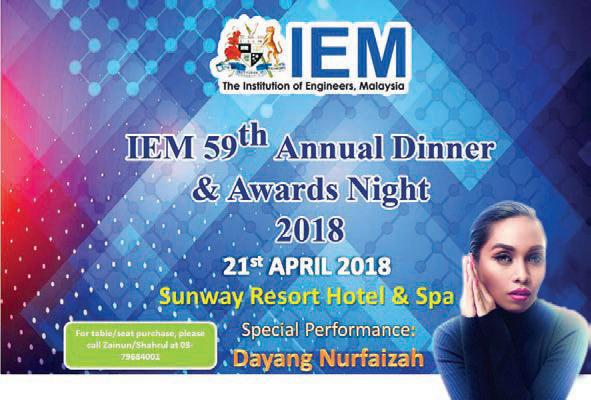

JURUTERA has an estimated readership of 168,000 professionals. Our esteemed readership consists of certified engineers, decision making corporate leaders, CEOs, government officials, project directors, entrepreneurs, project consultants, engineering consulting firms and companies involved with engineering products and services.
Our business partners can be assured that their products and services will be given the circulation and exposure it deserves, thus maintaining a sustained advertising presence to our core readers of decision-making engineers and technical experts. Our website offers an even wider market reach, with added international presence, aided by our international affiliation with official engineering bodies all over the world. Our online and offline advertising features such as banner advertising, article sponsorship and direct e-mail announcements have proven to be successful marketing strategies that will set the businesses of our partners apart from their competition.
For advertising enquiries, please contact:














note that the above prices exclude the 6% GST (Tax rate will be subjected to government changes)



